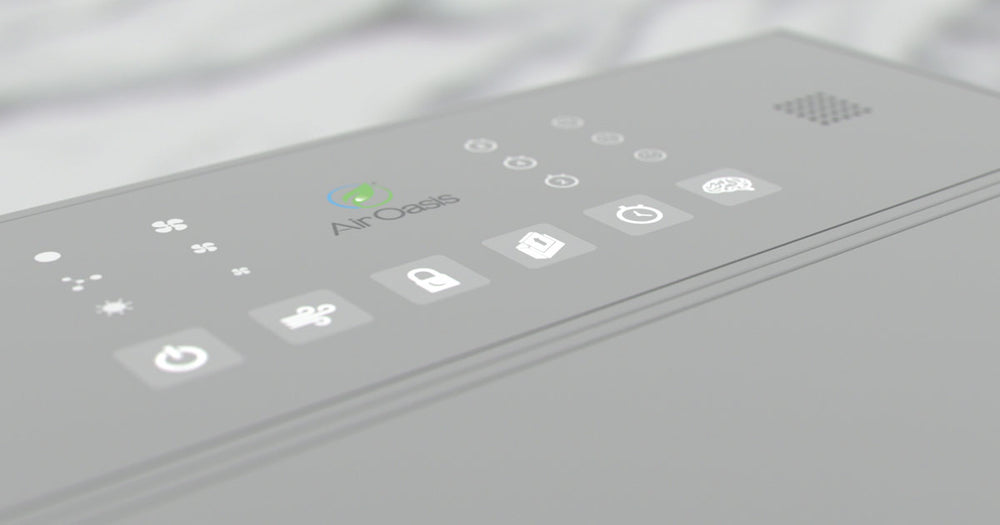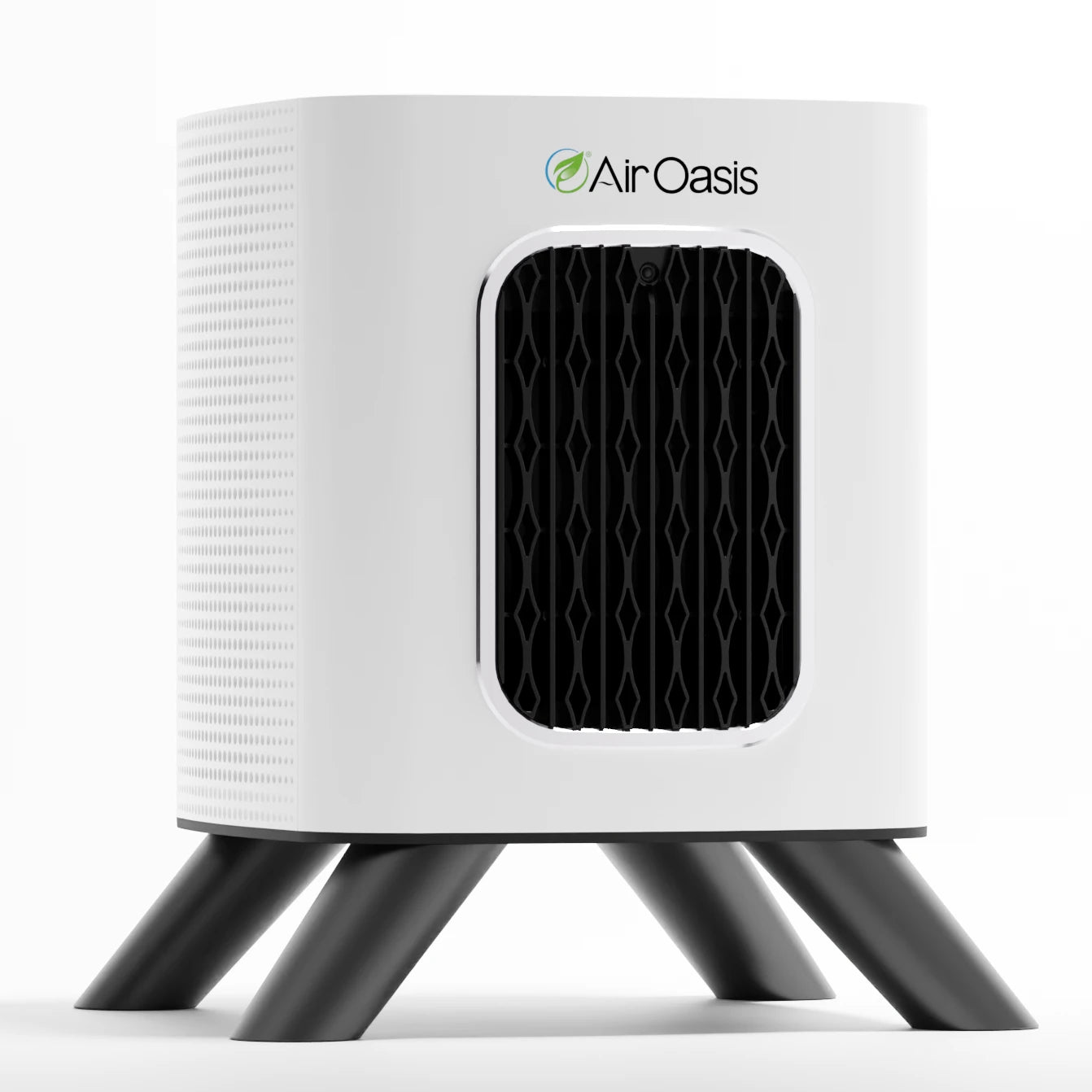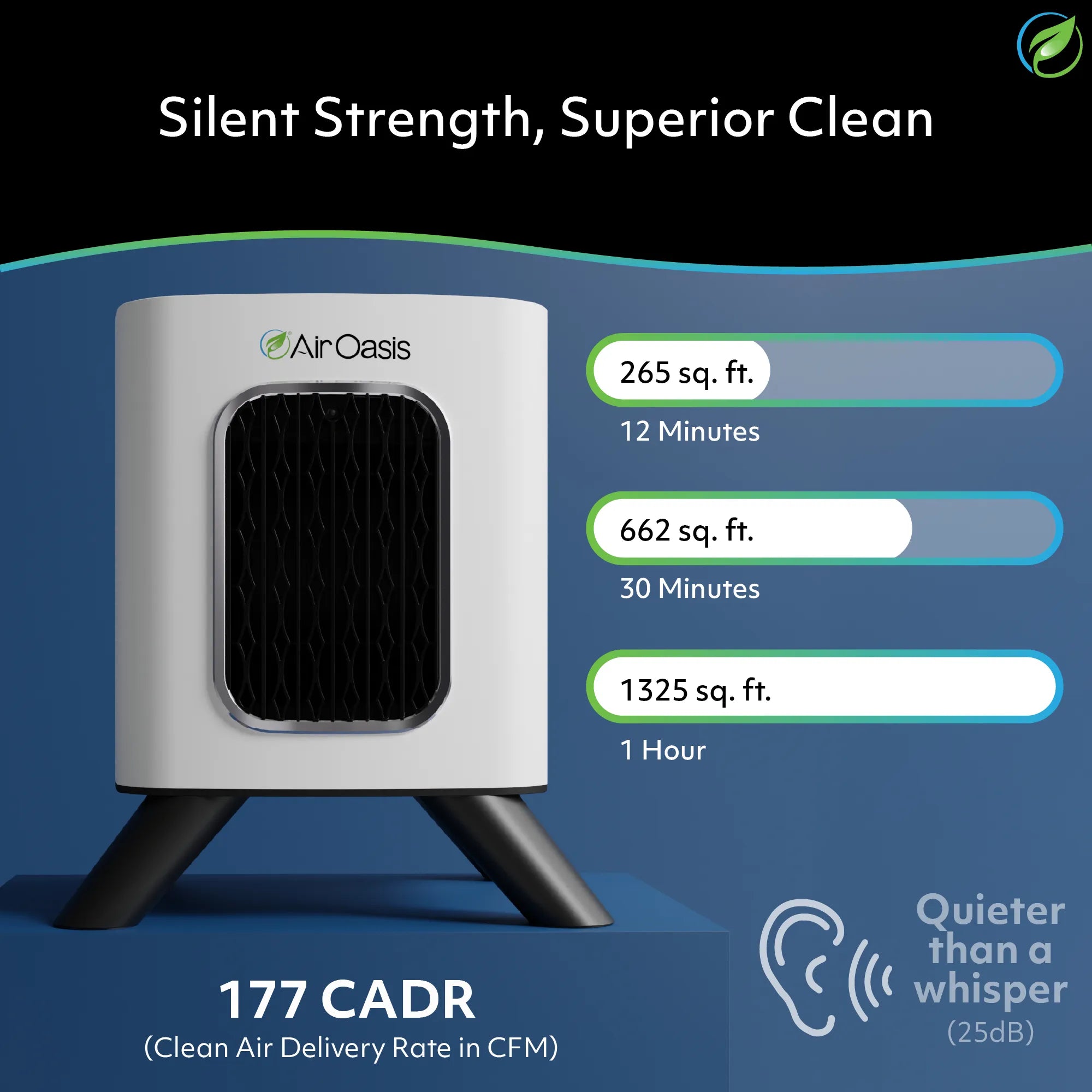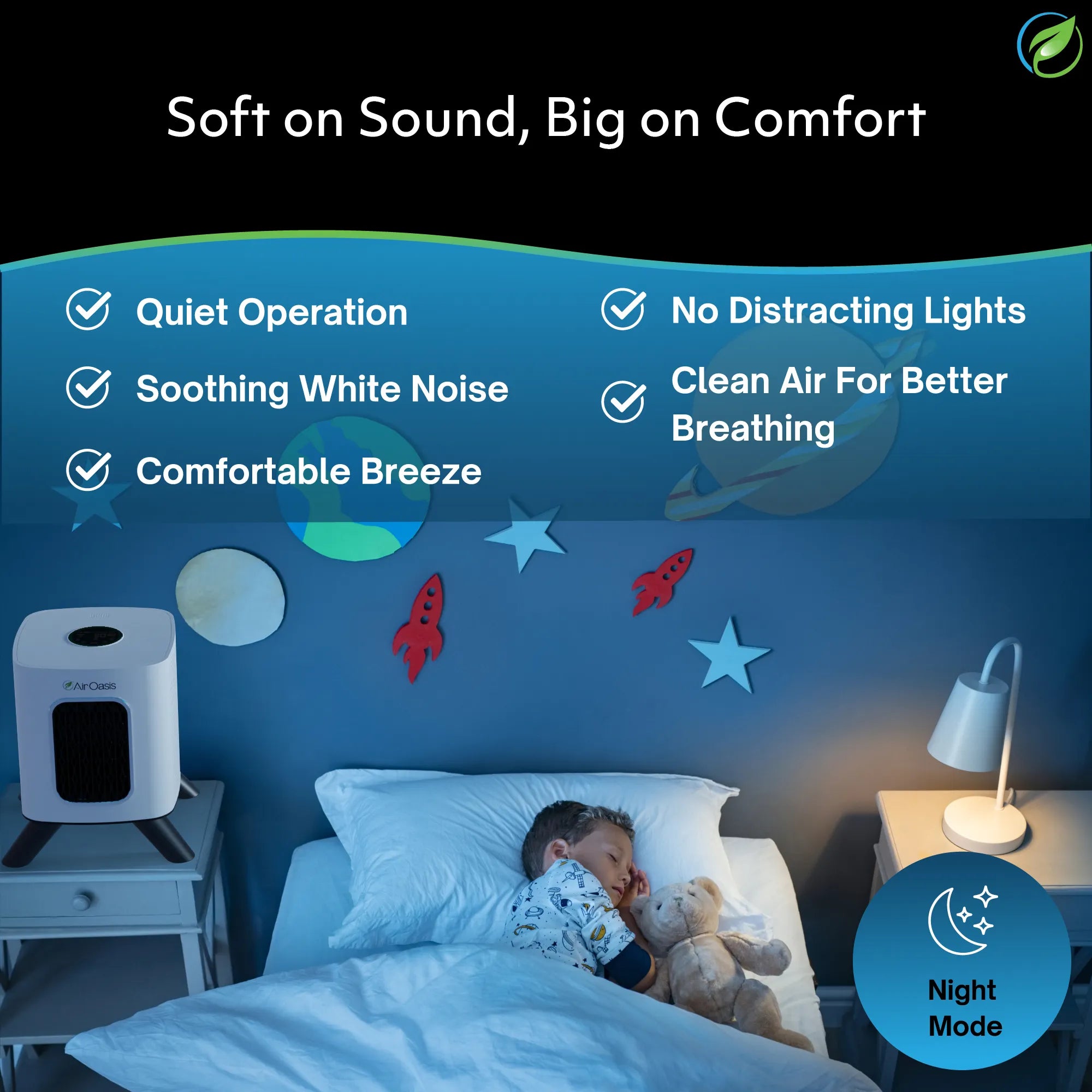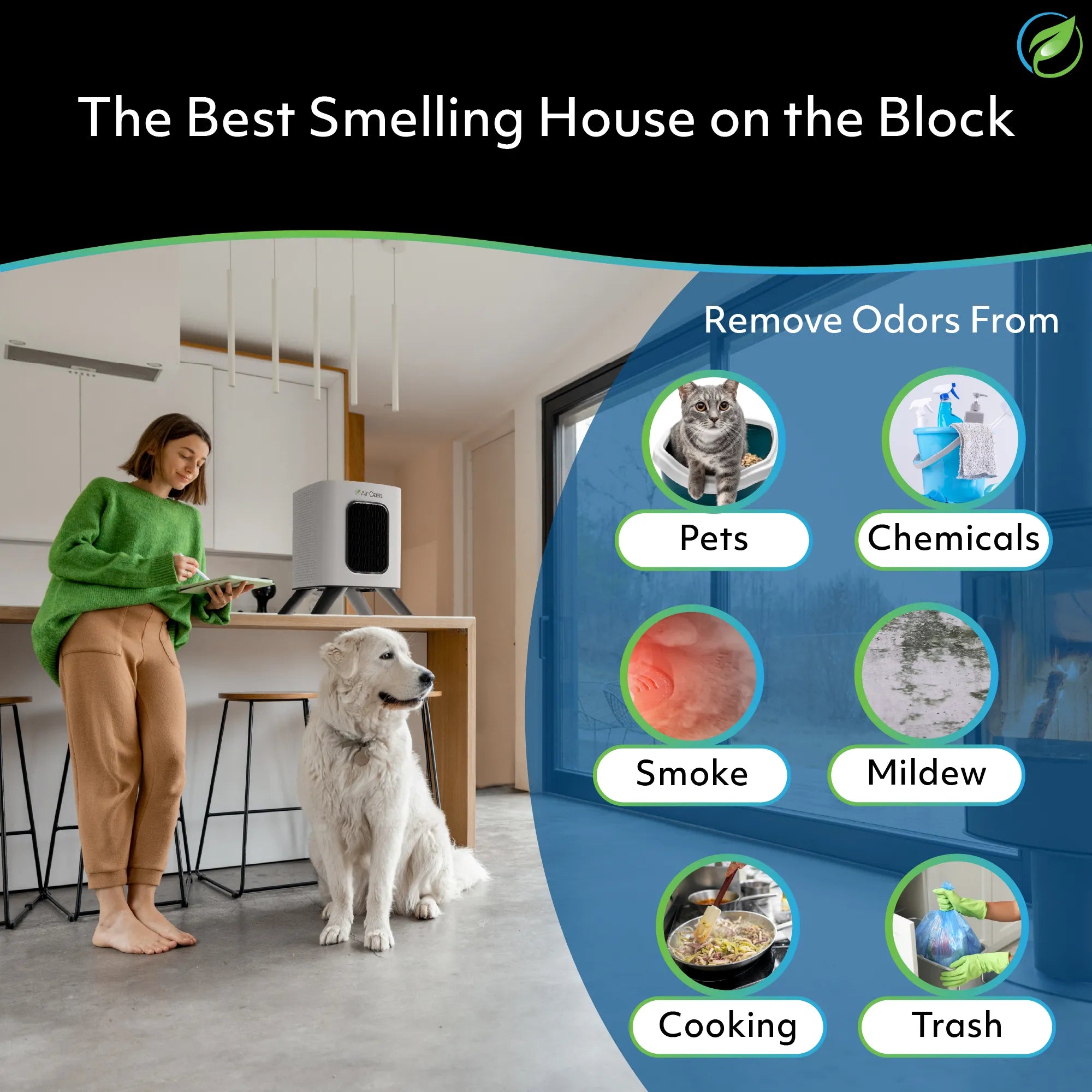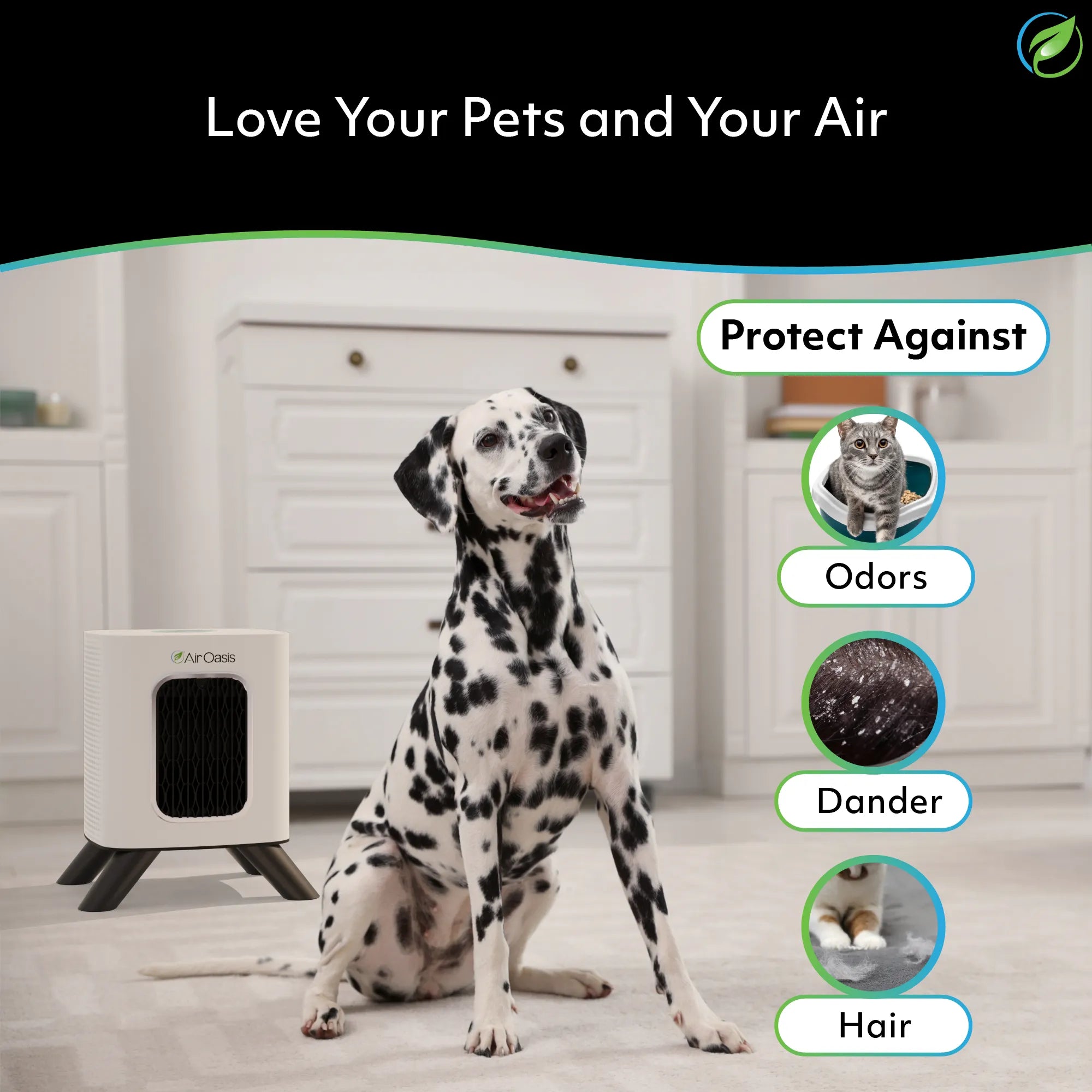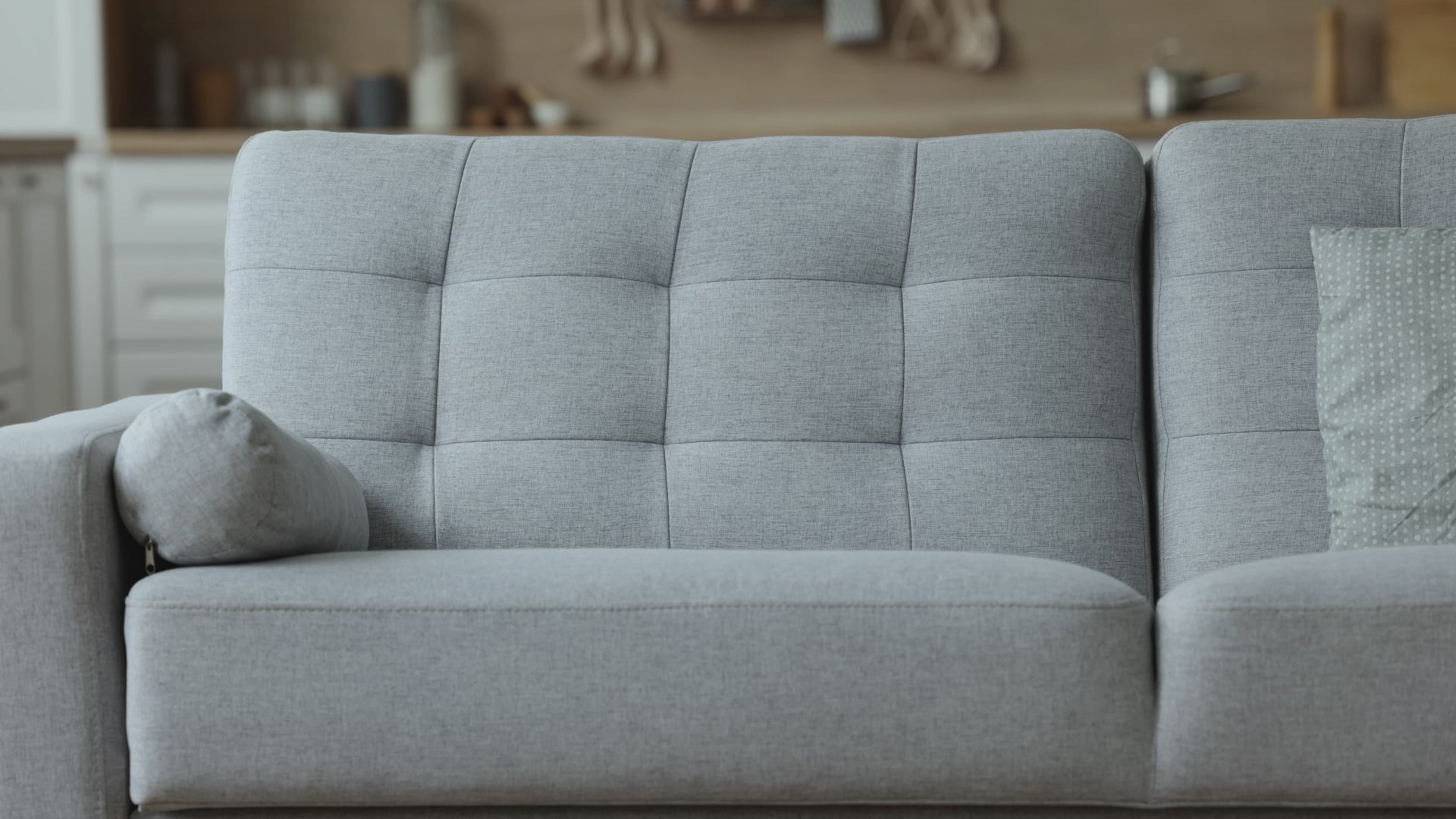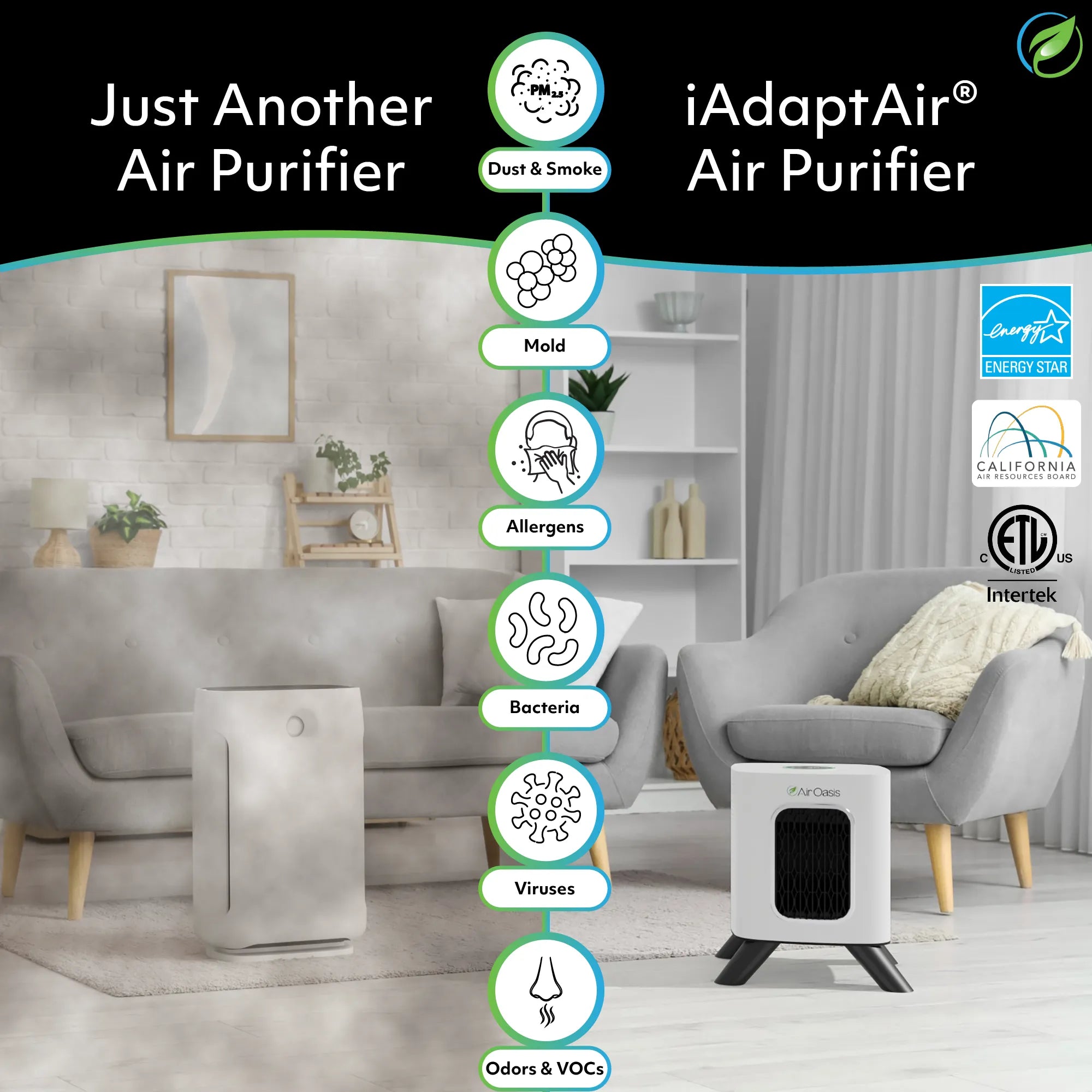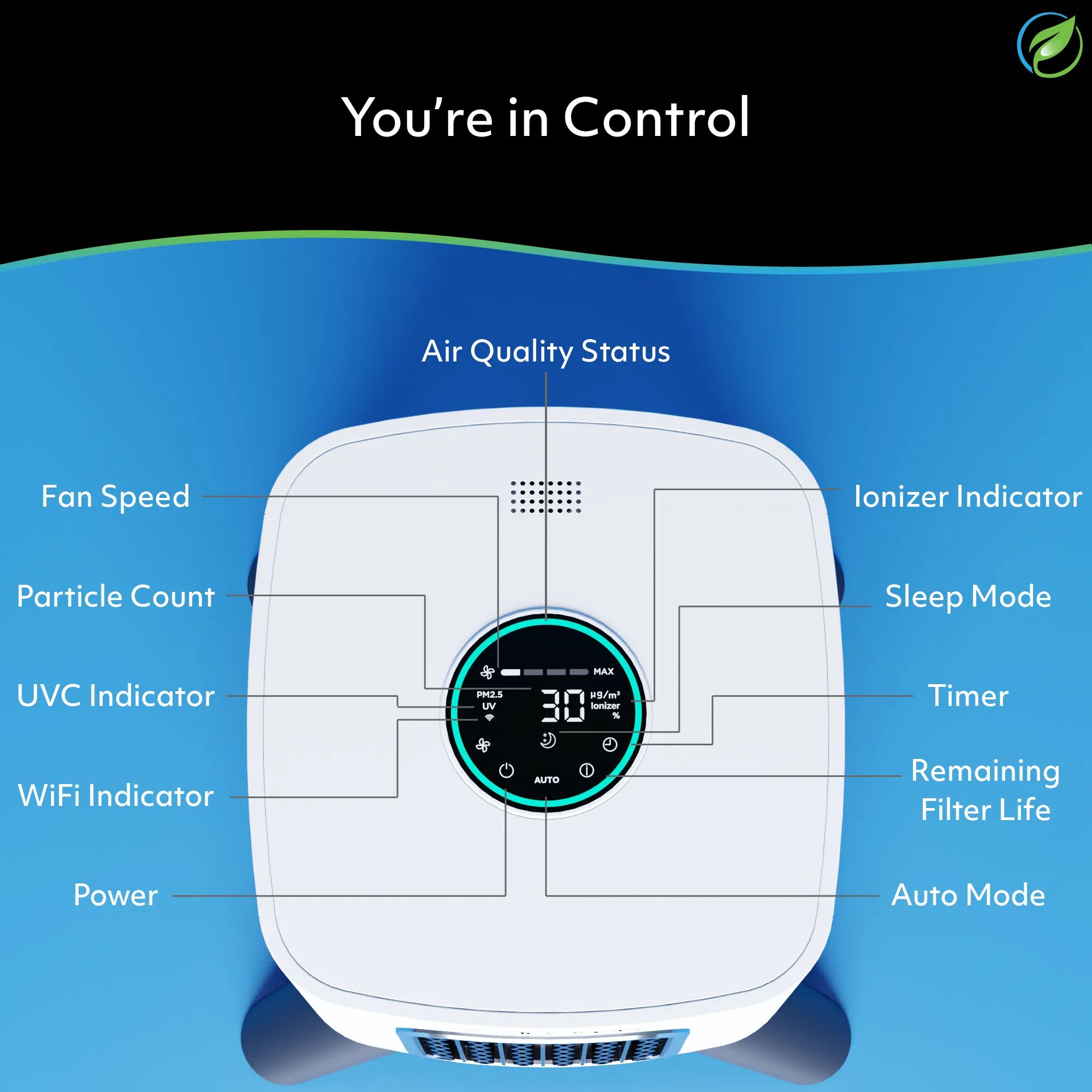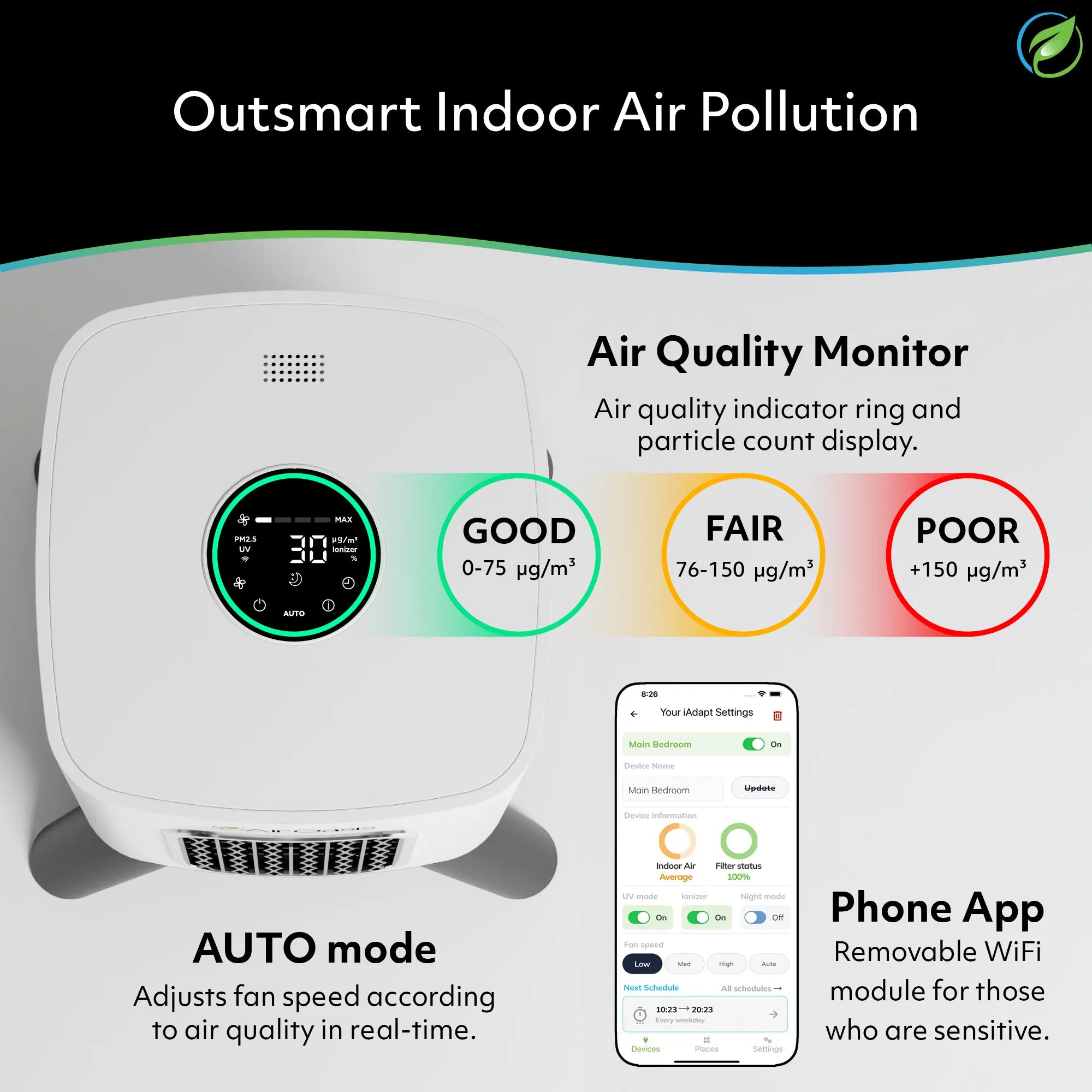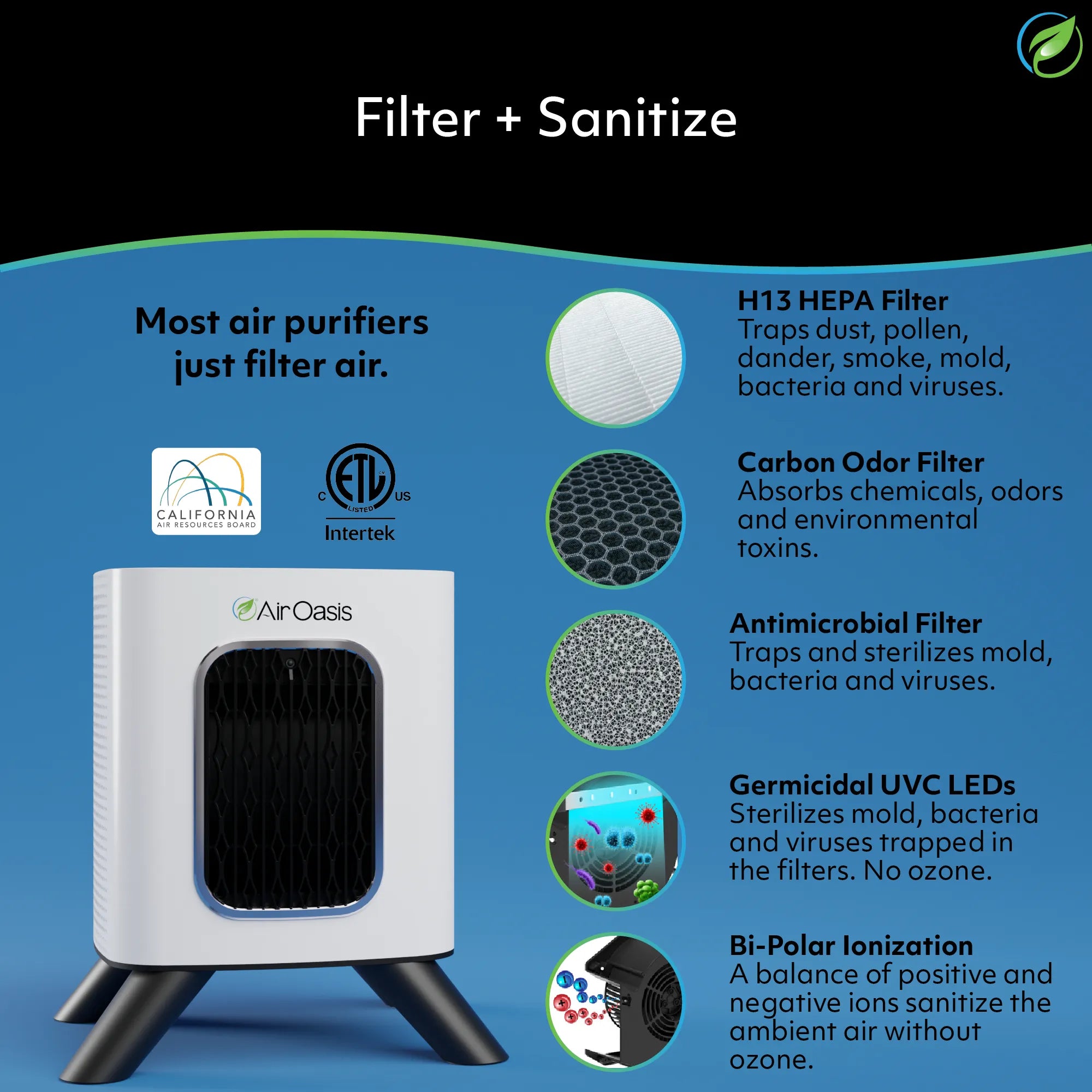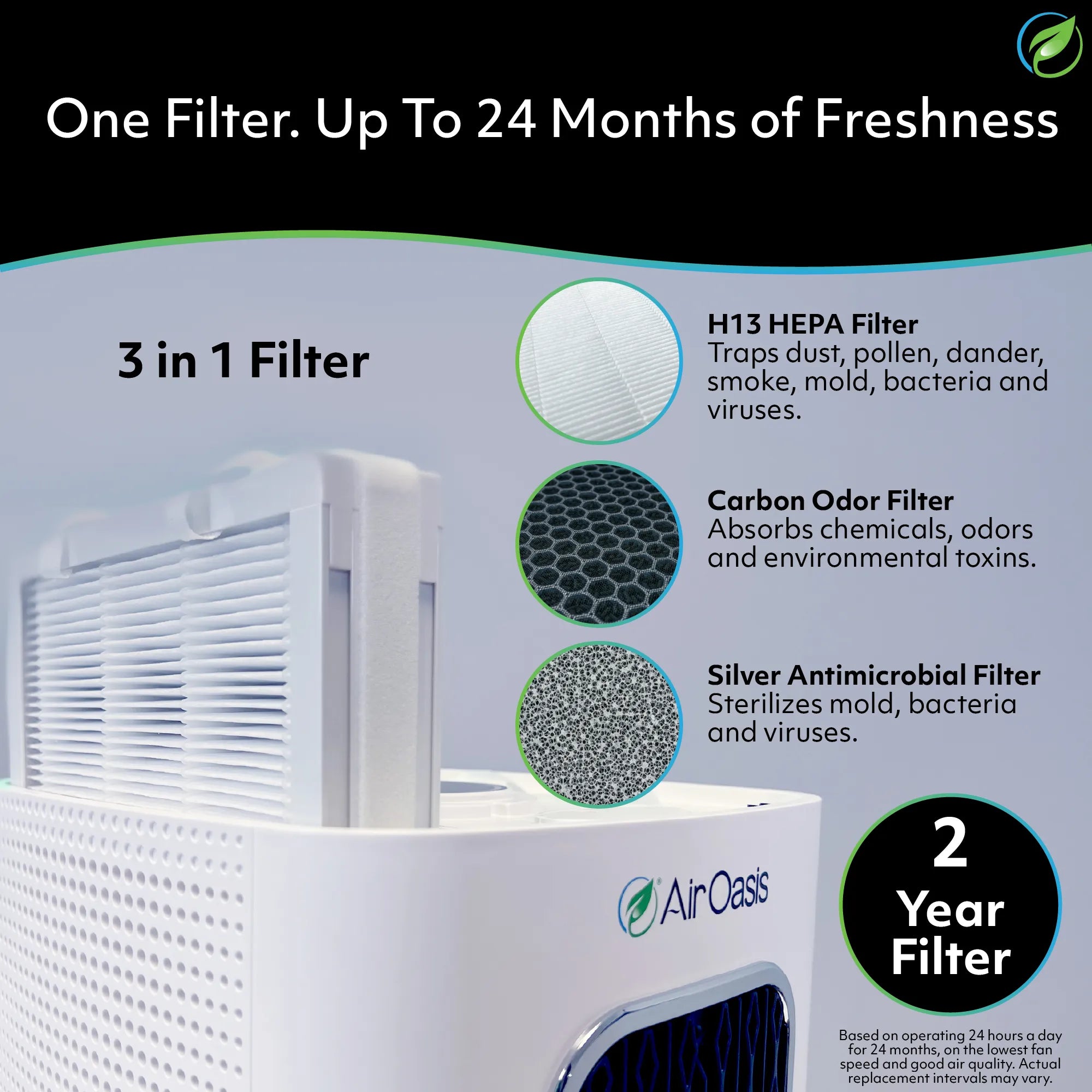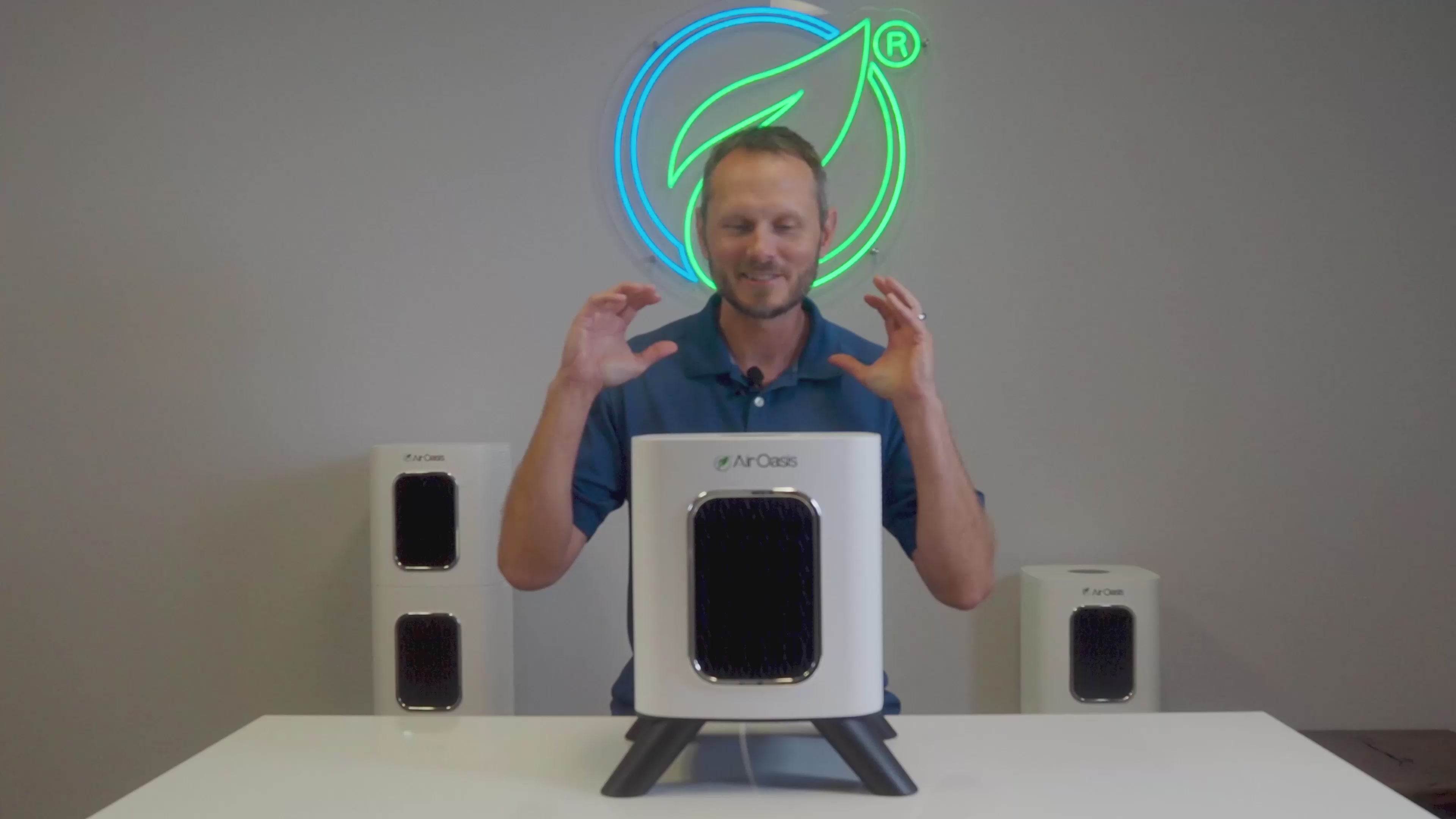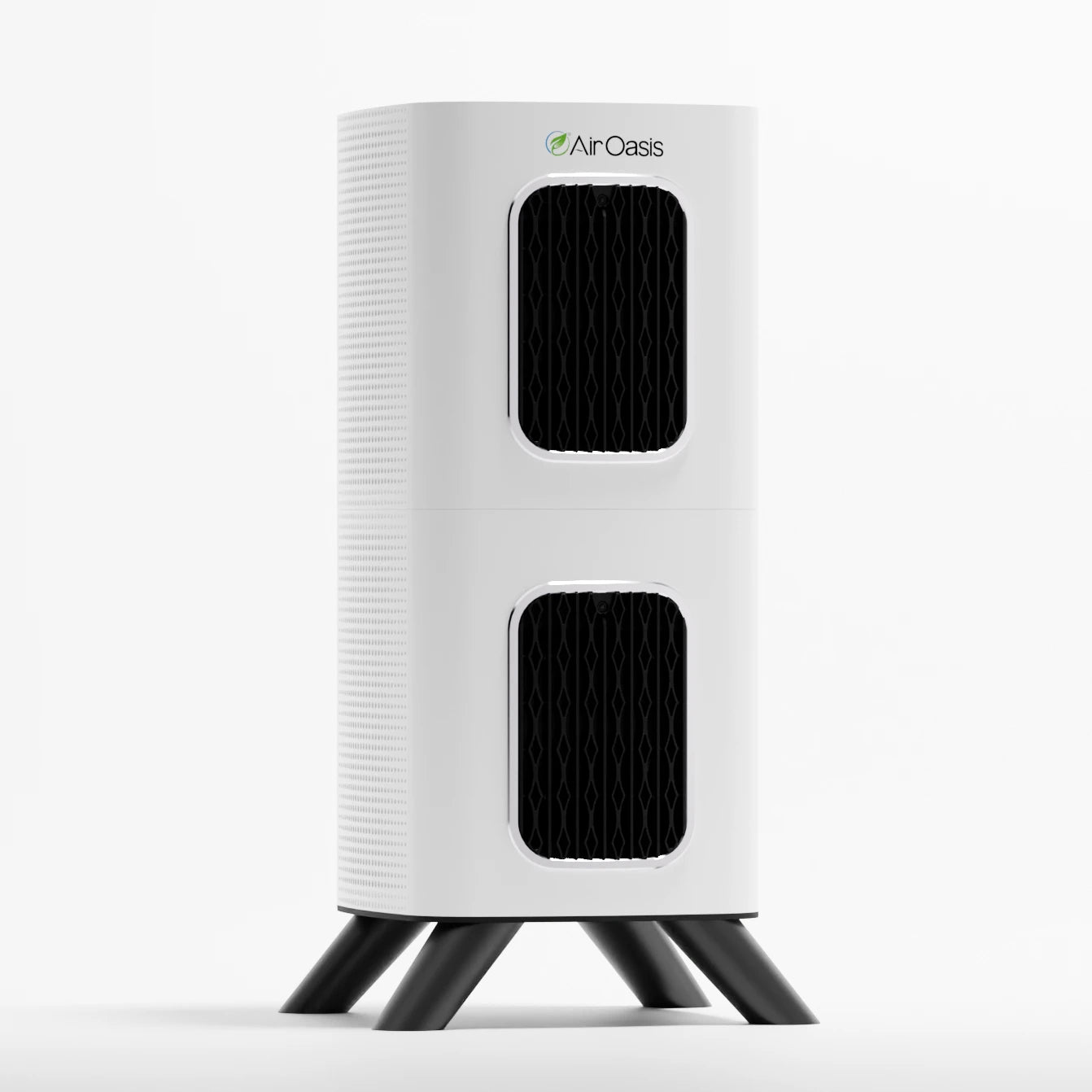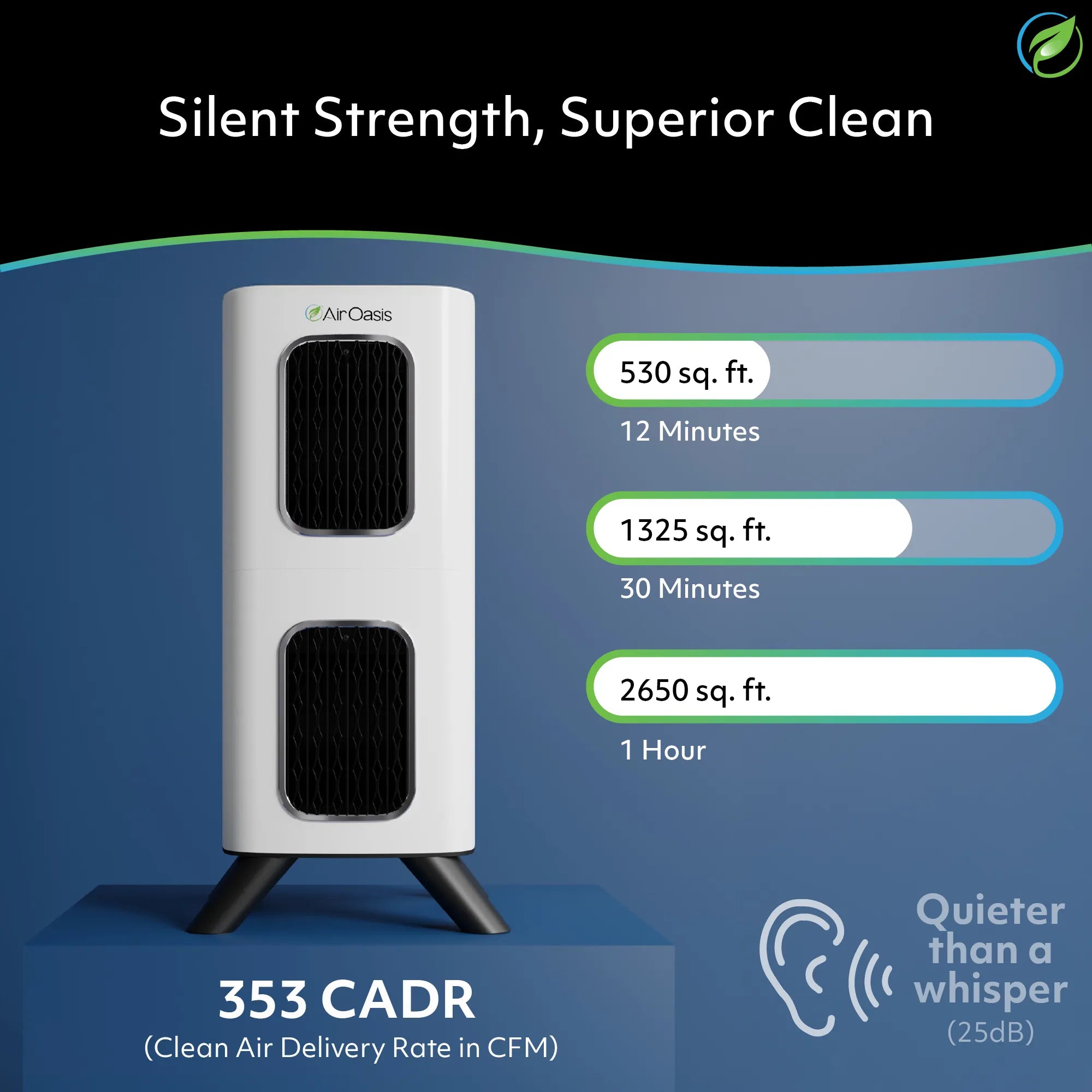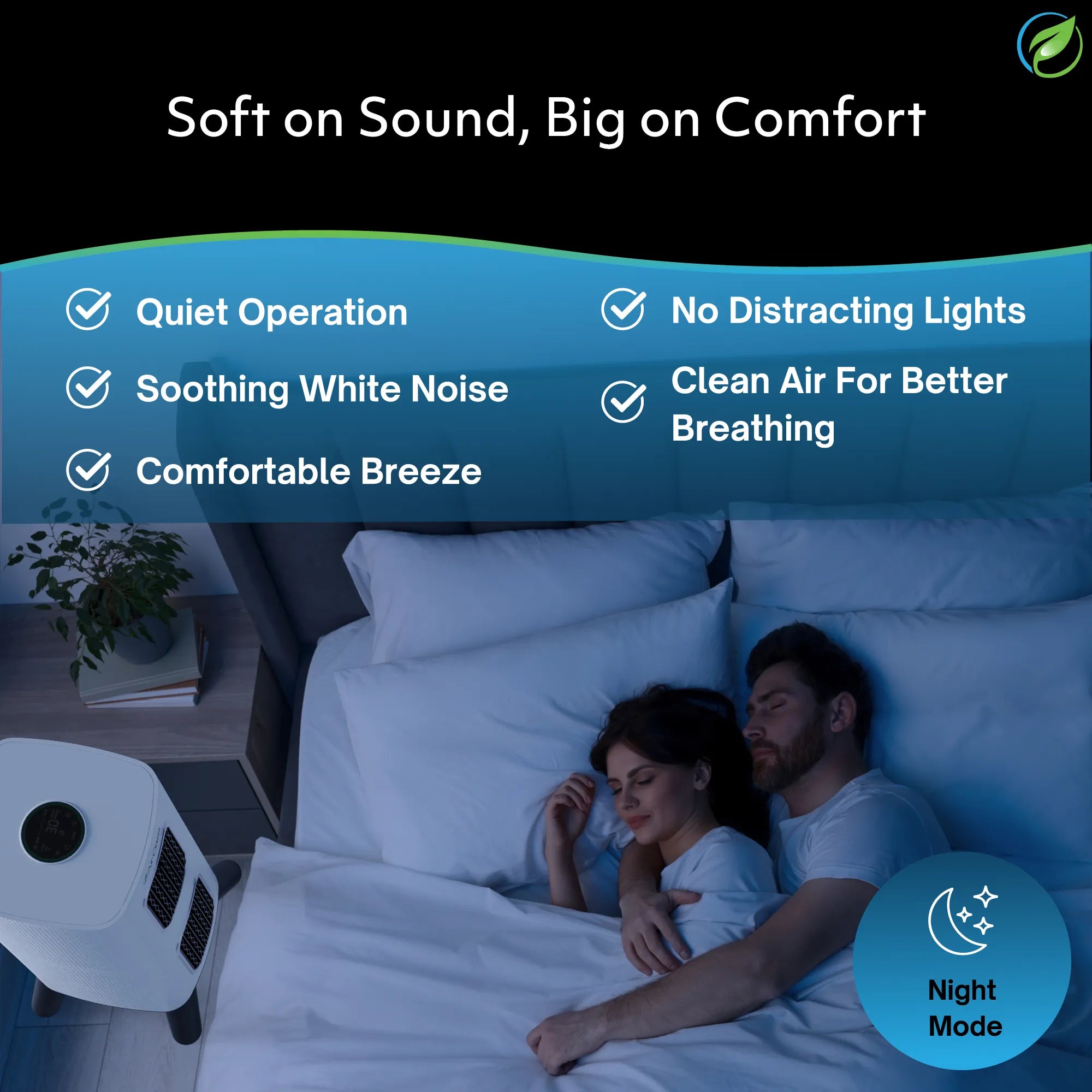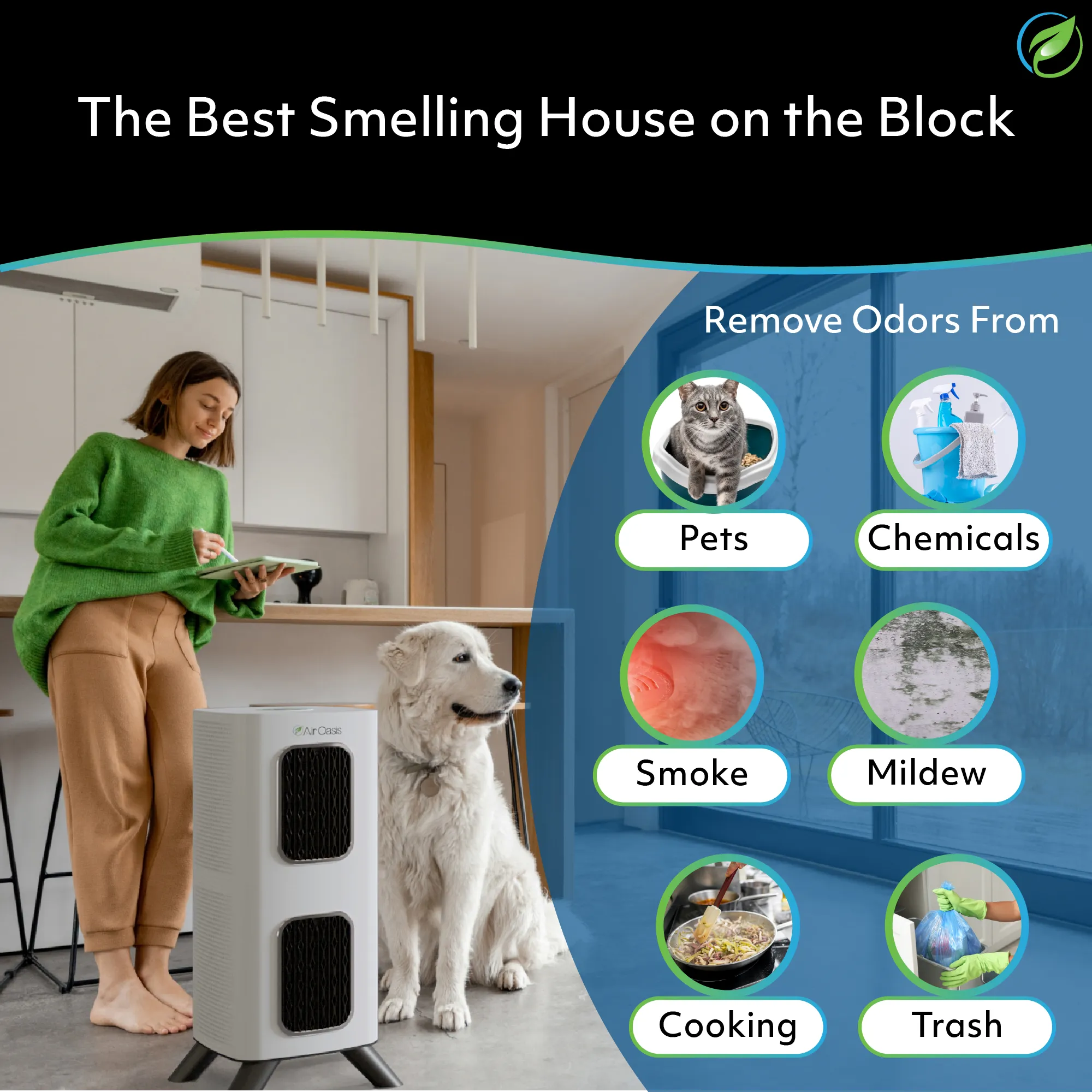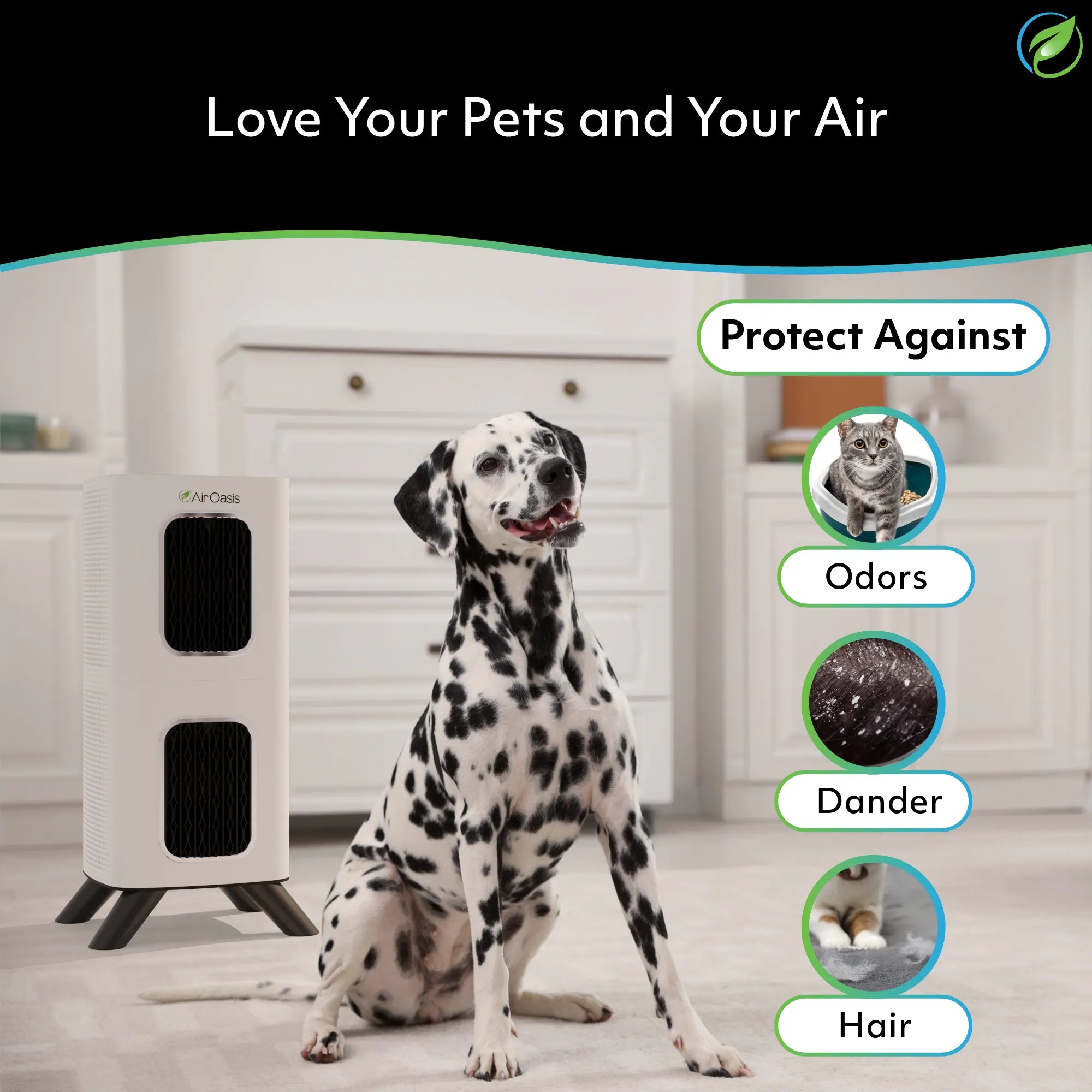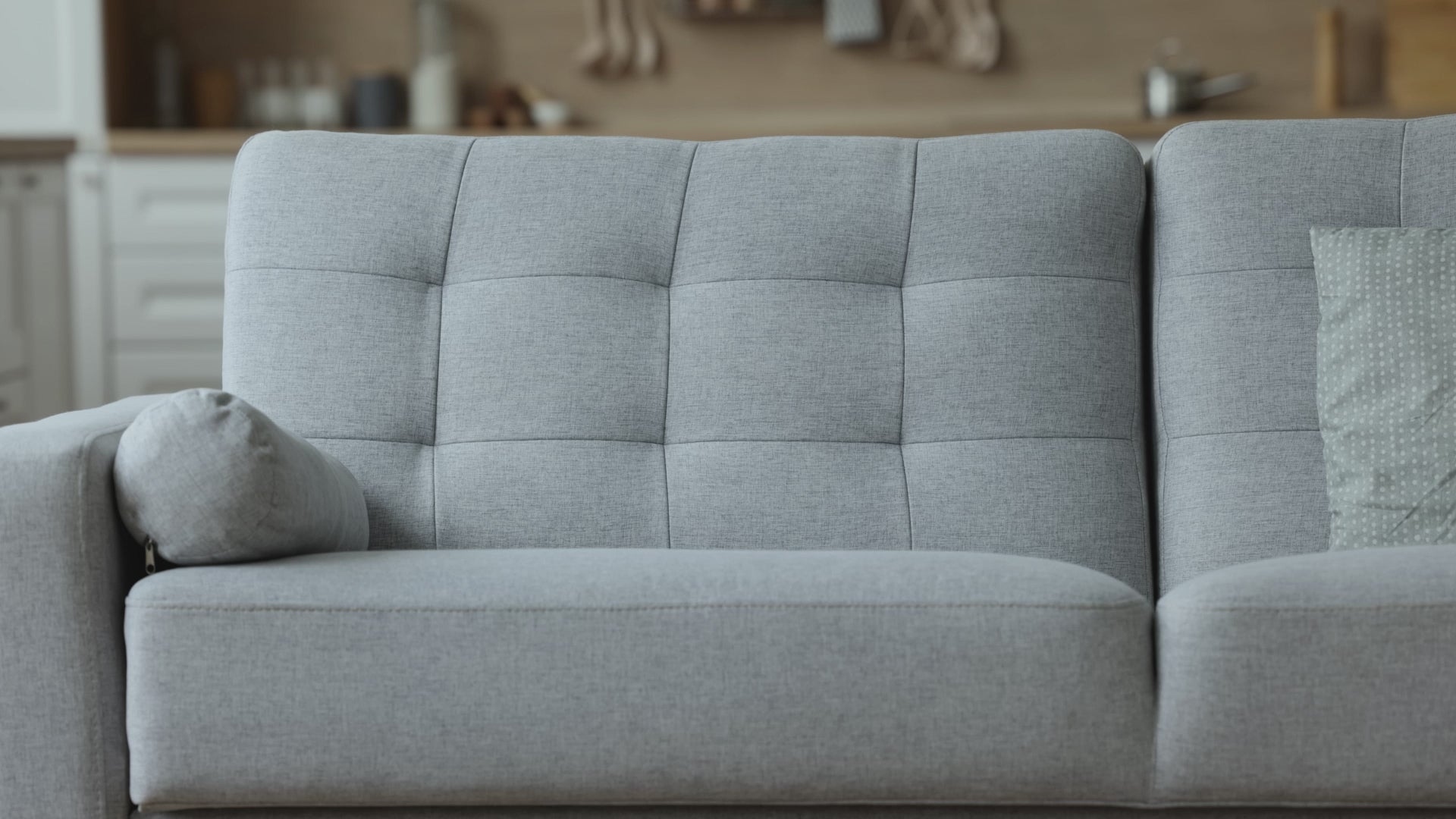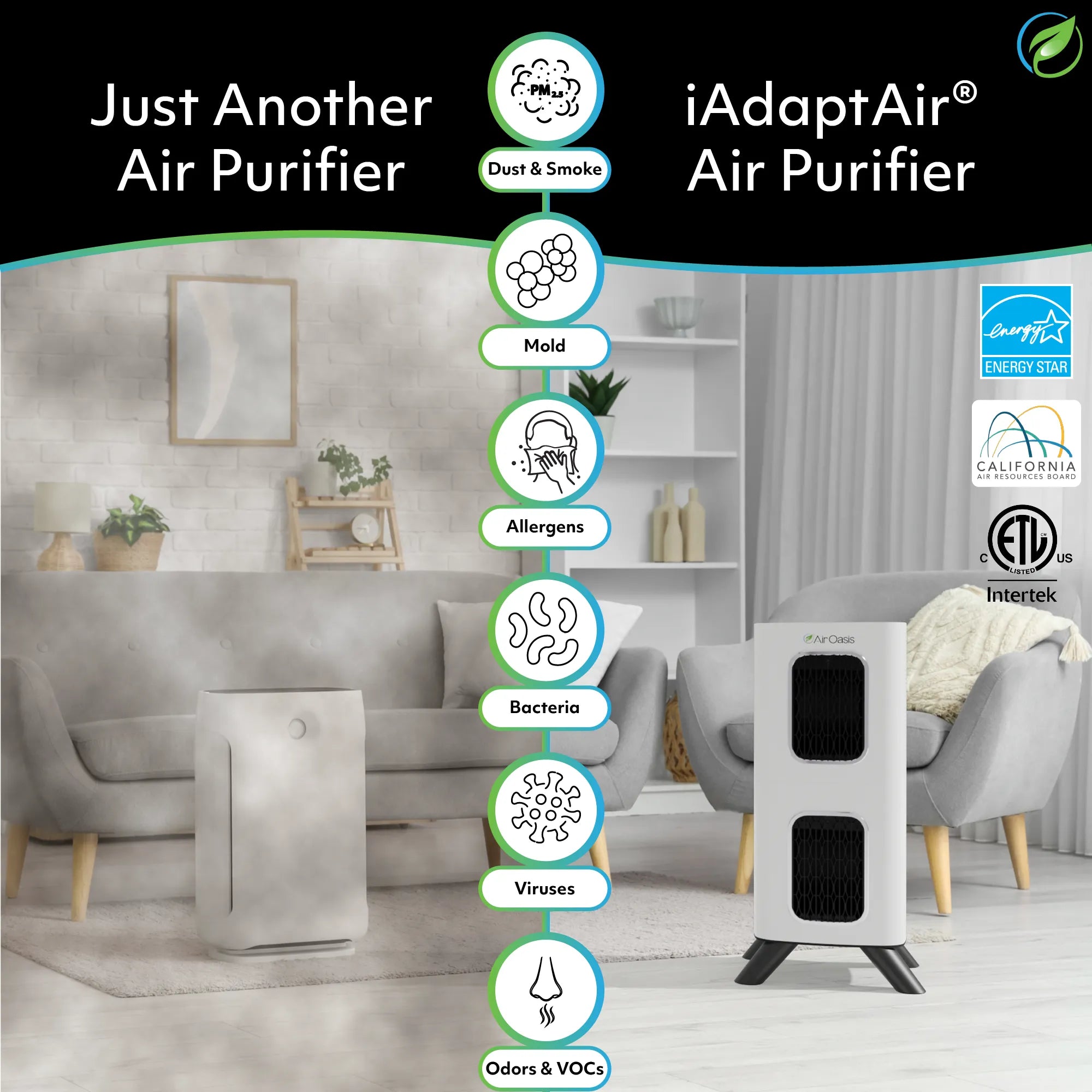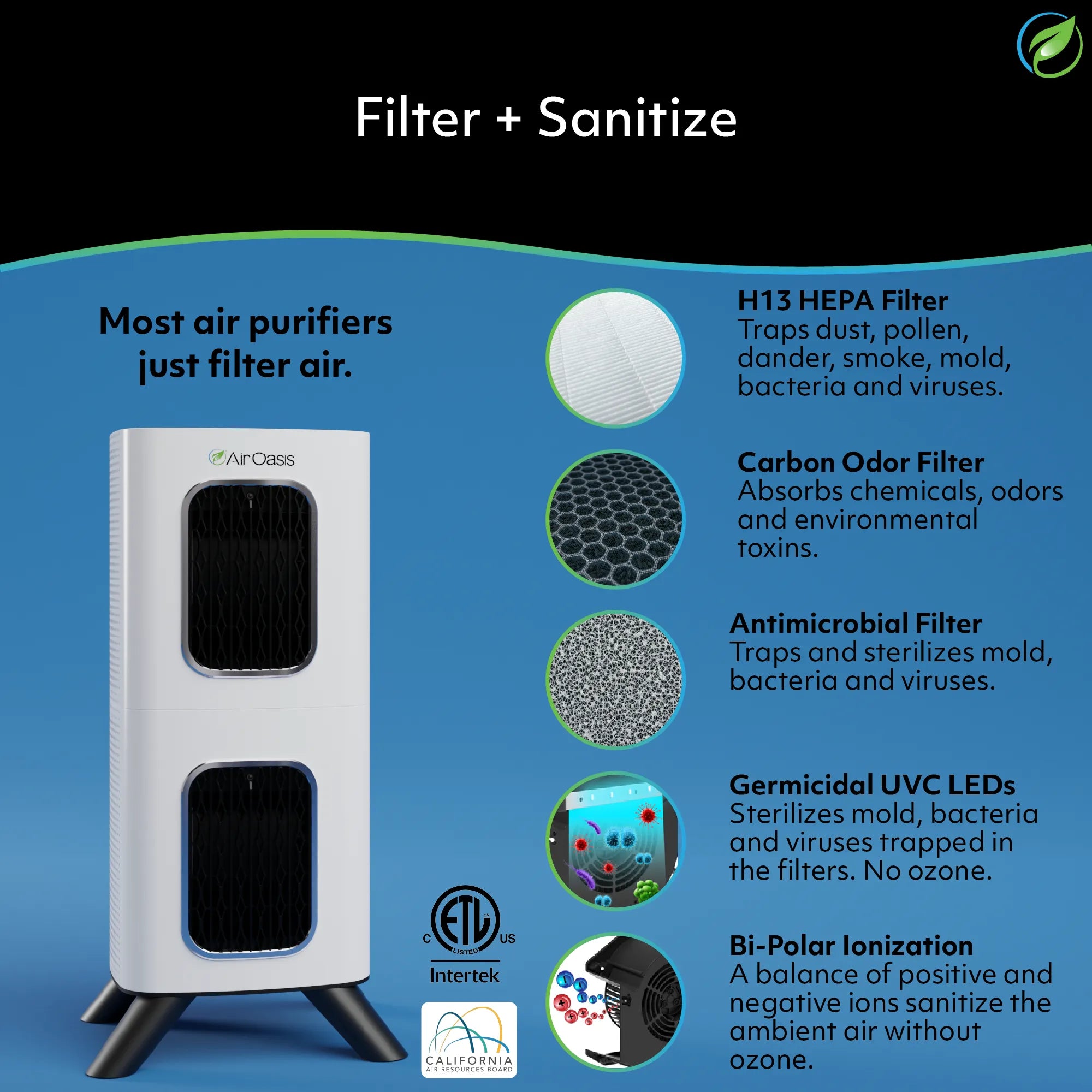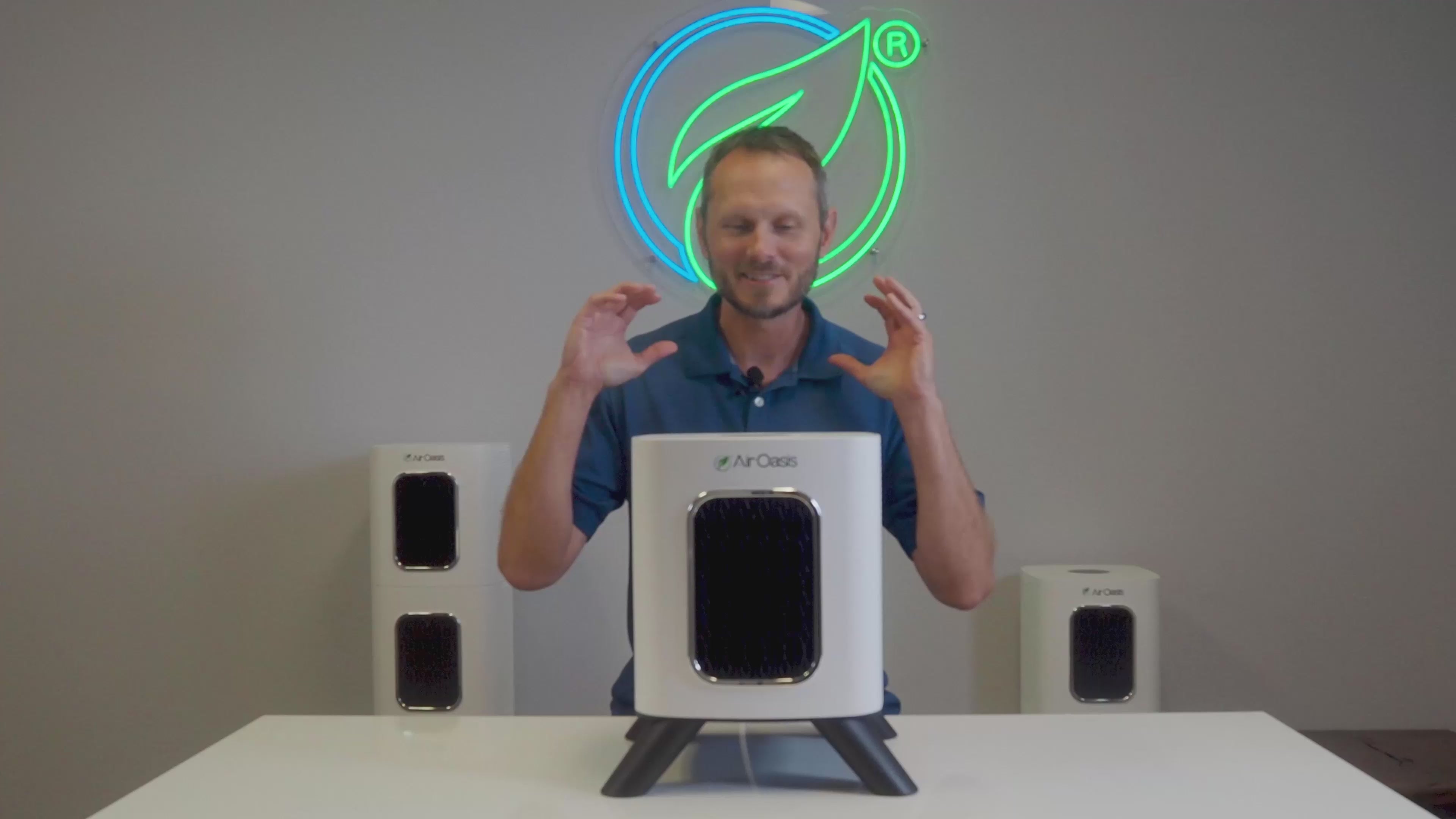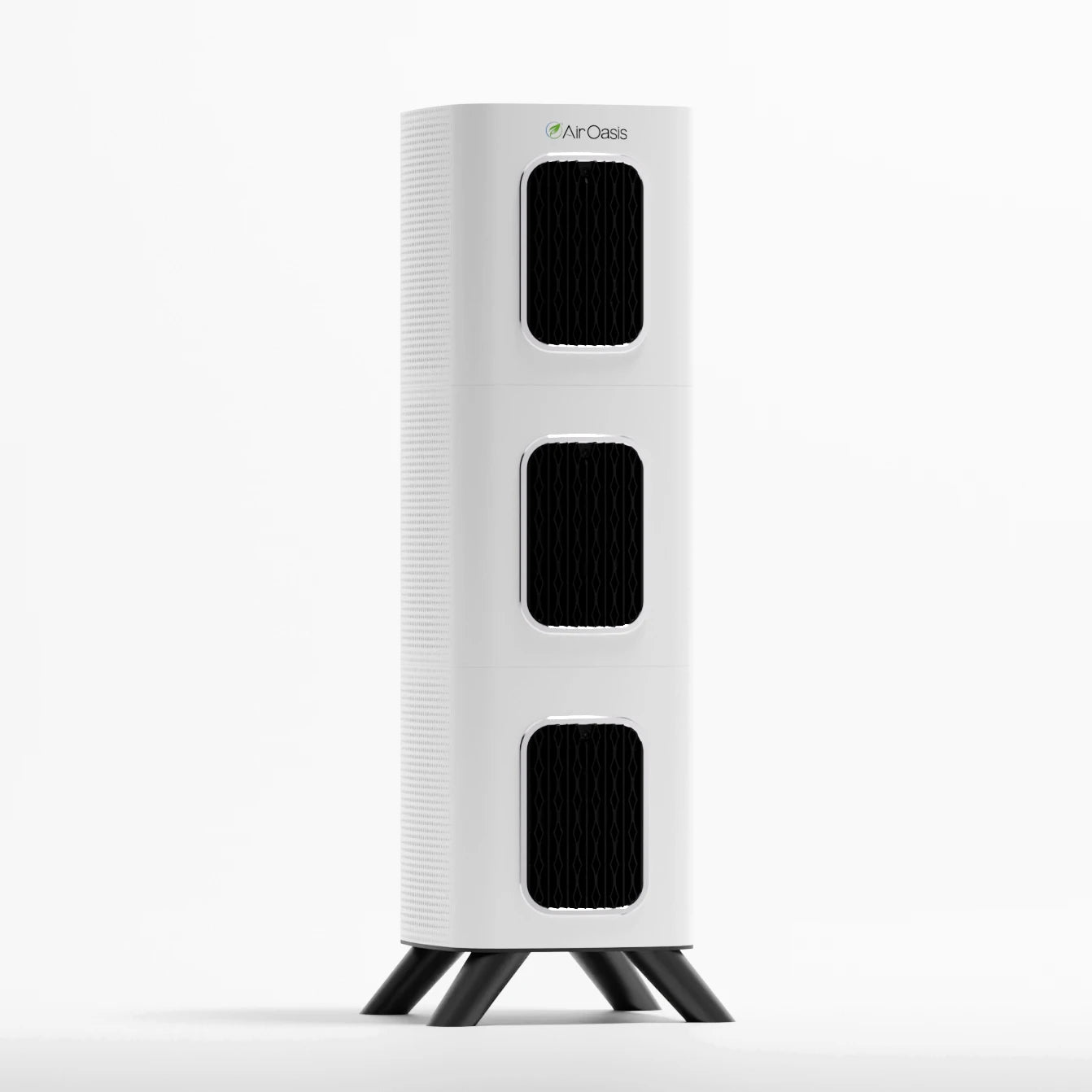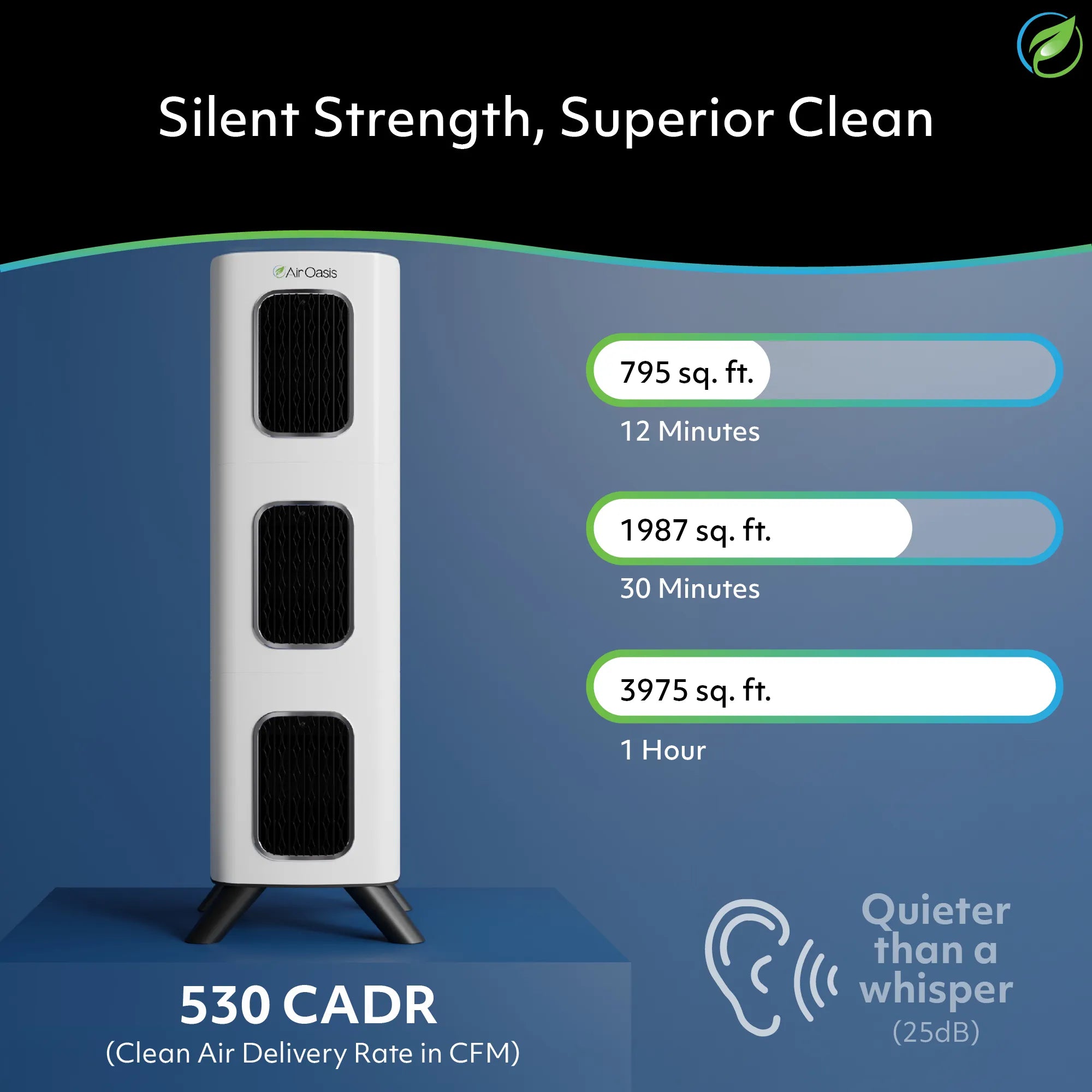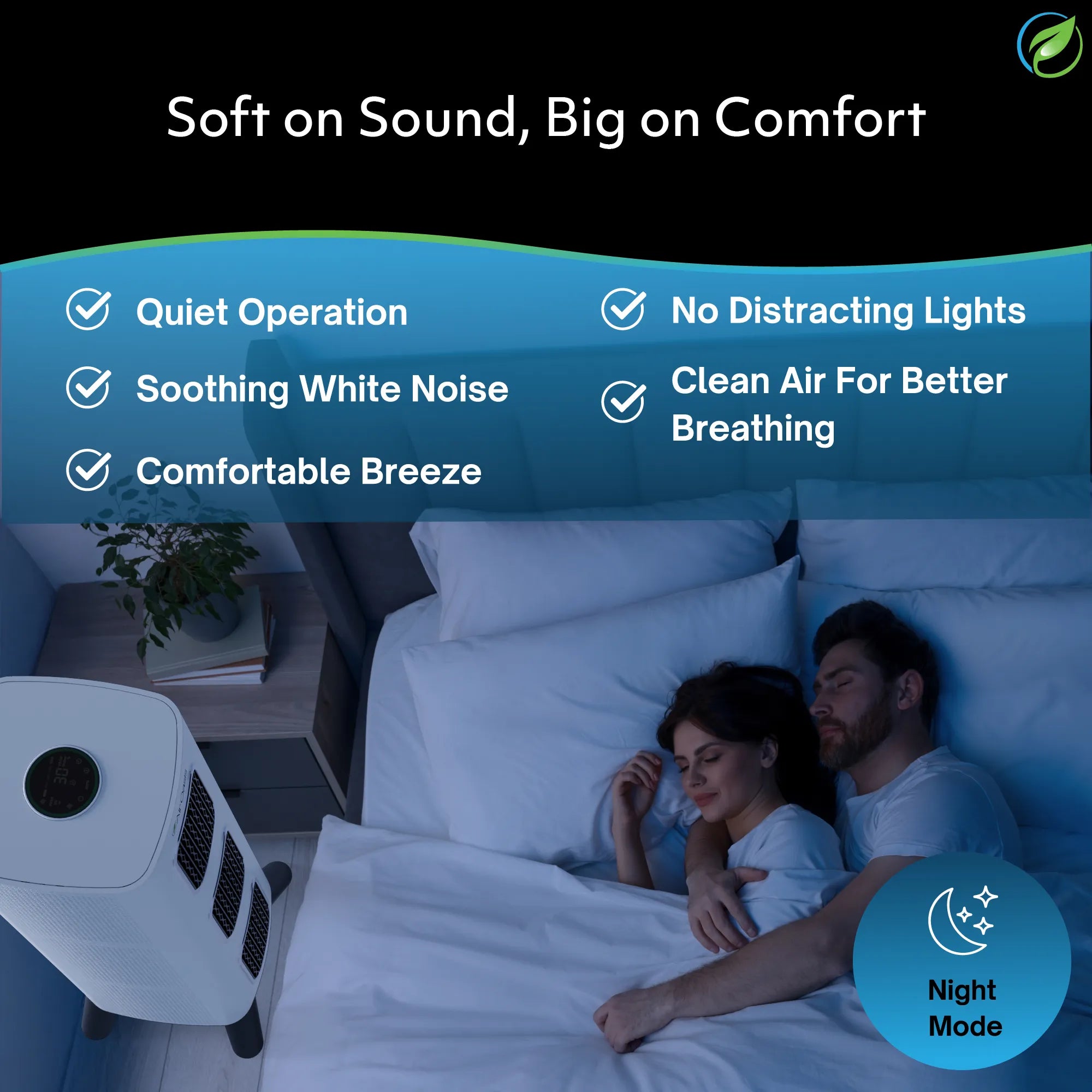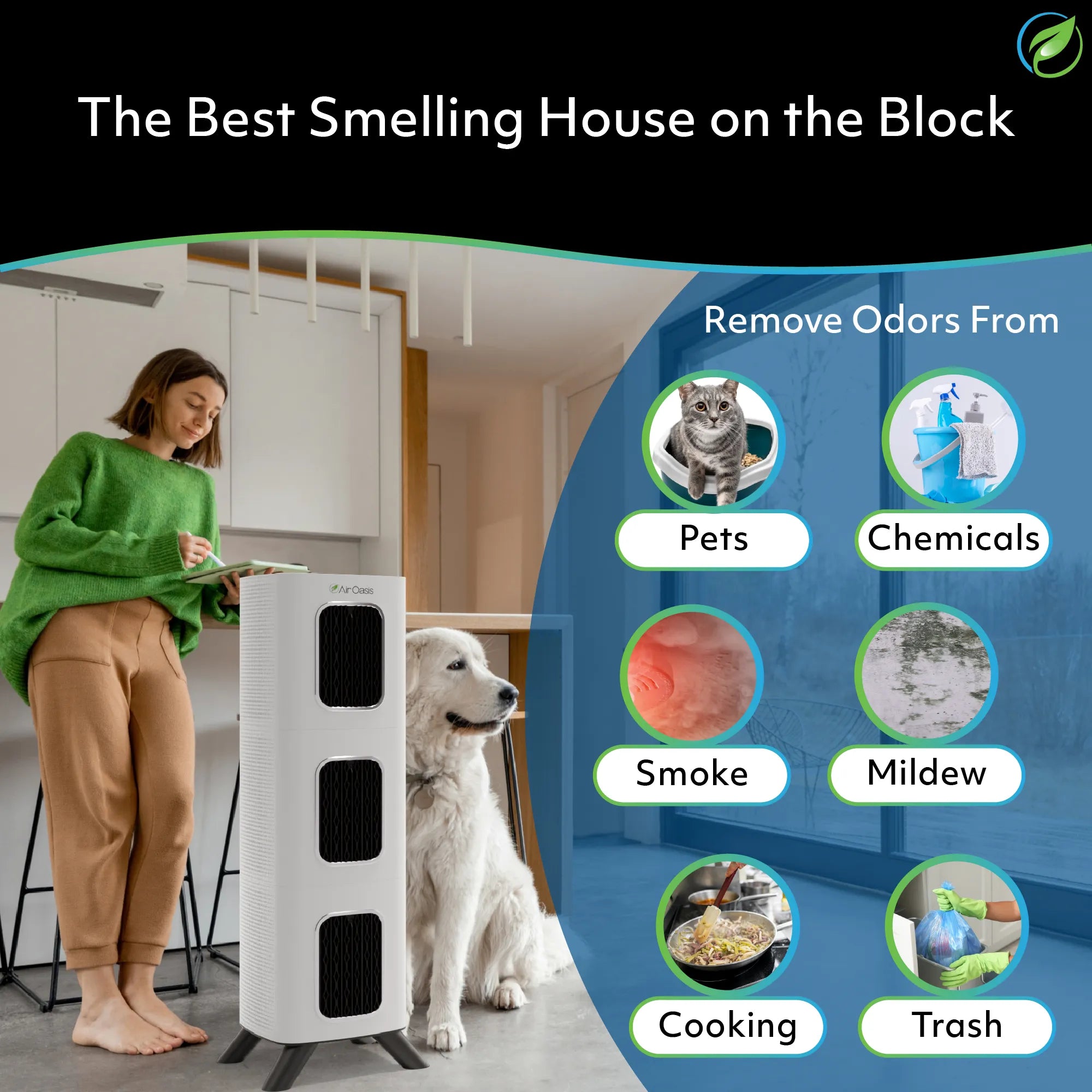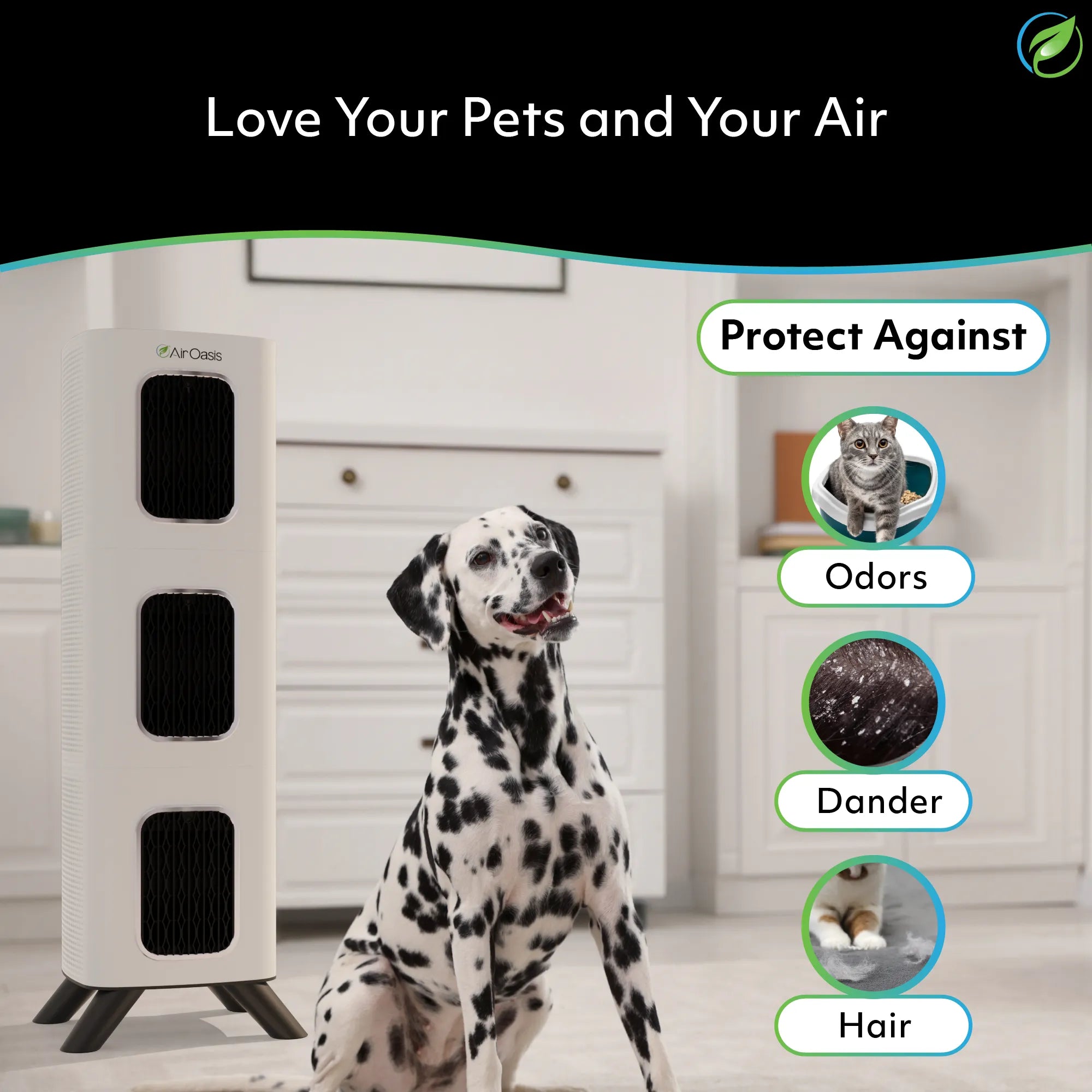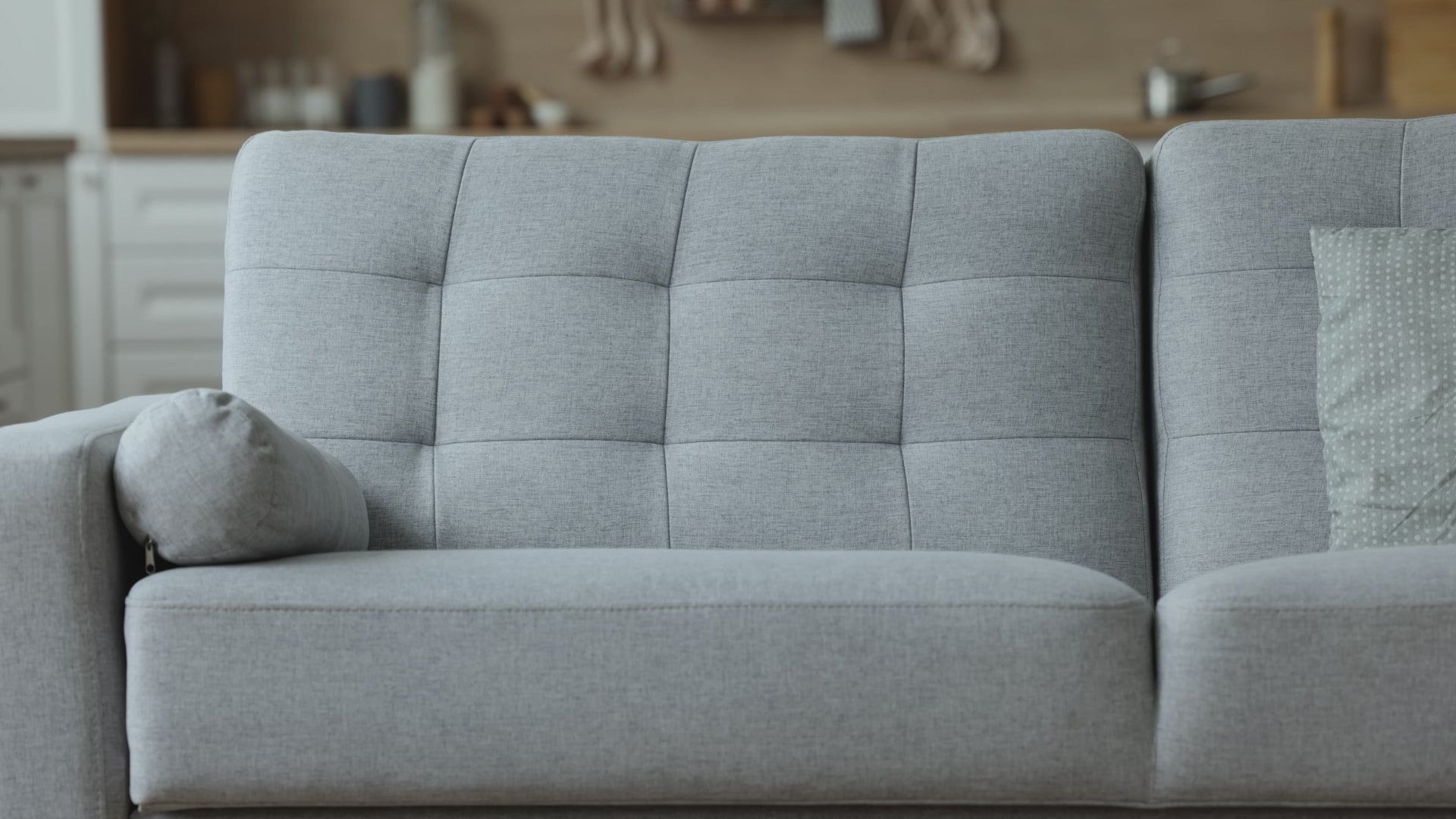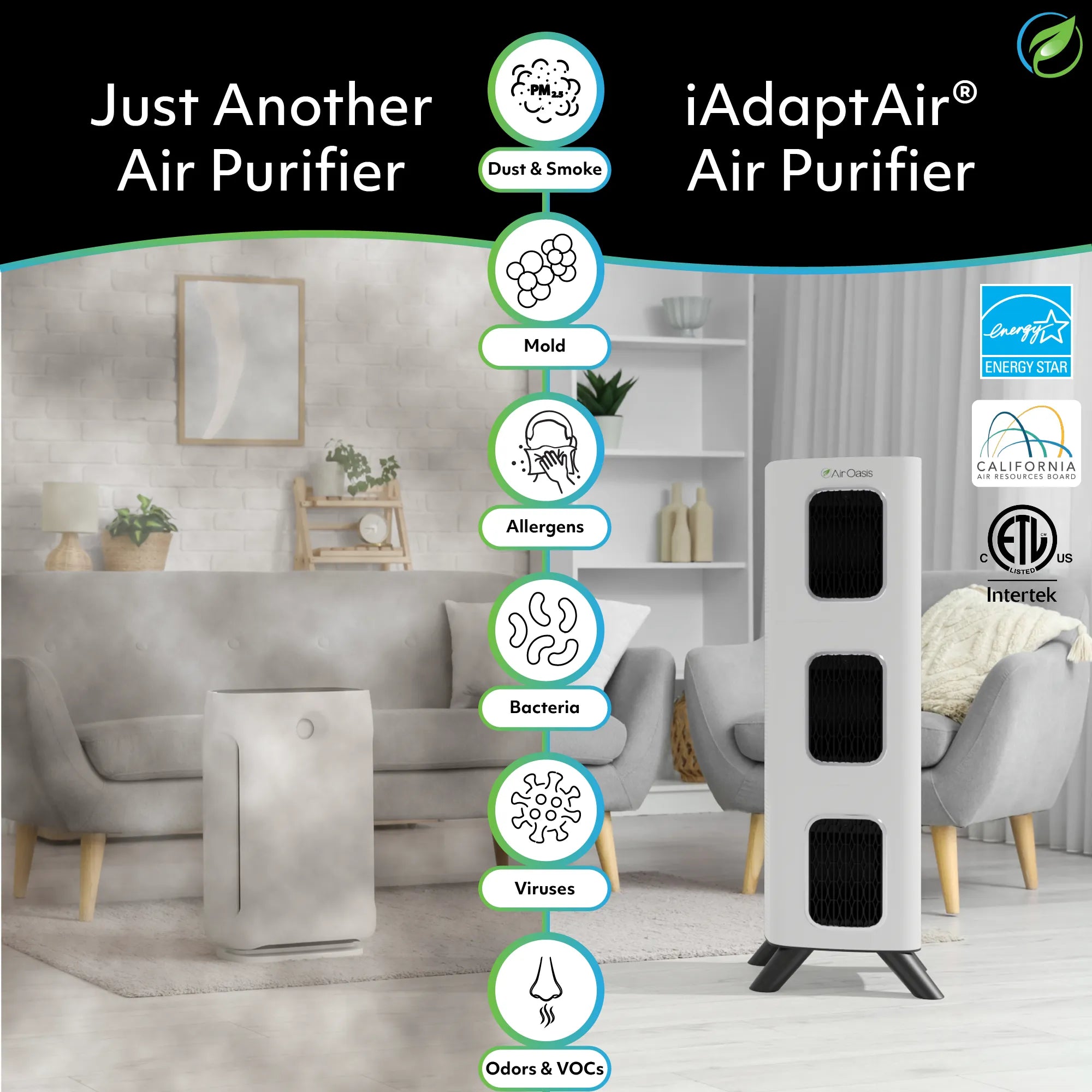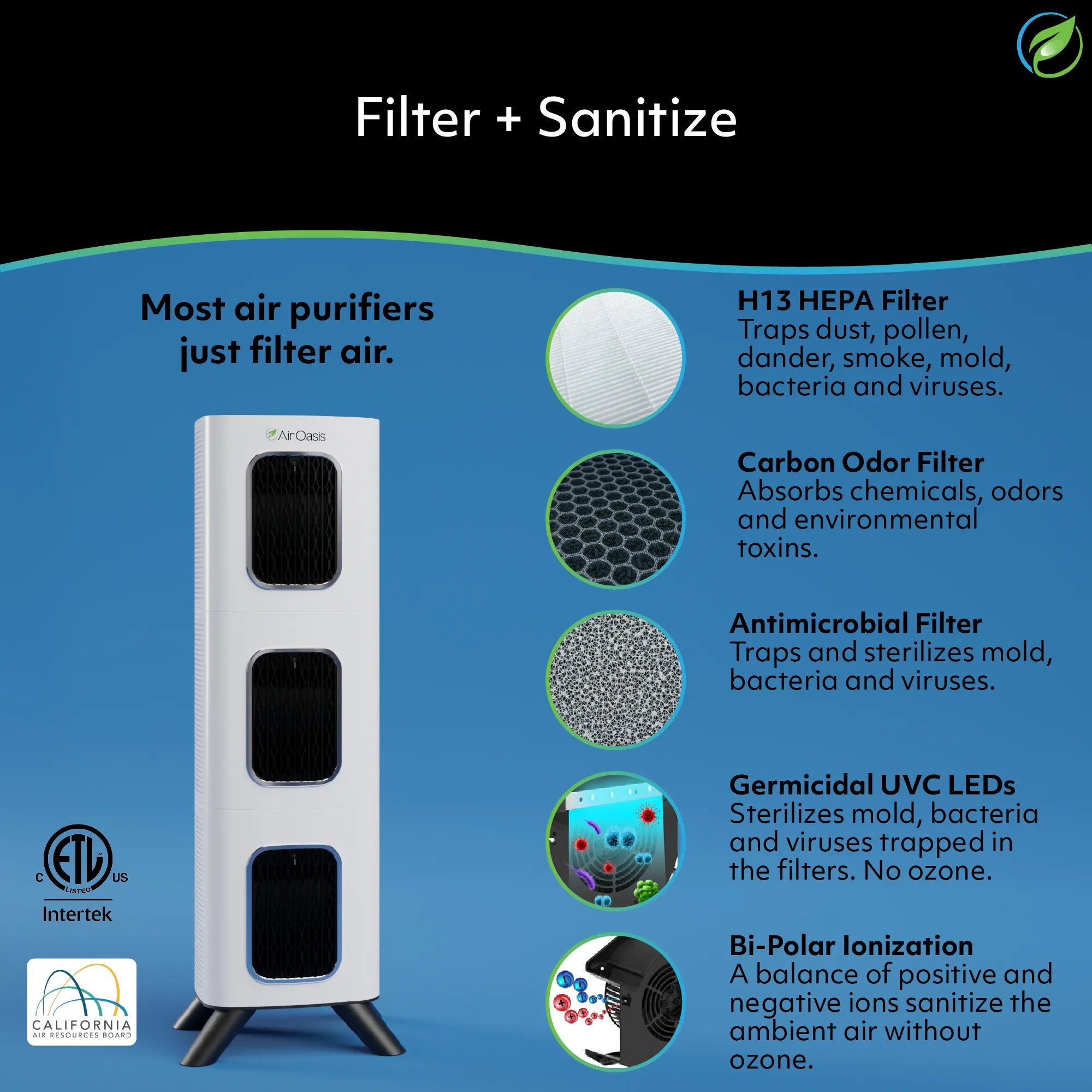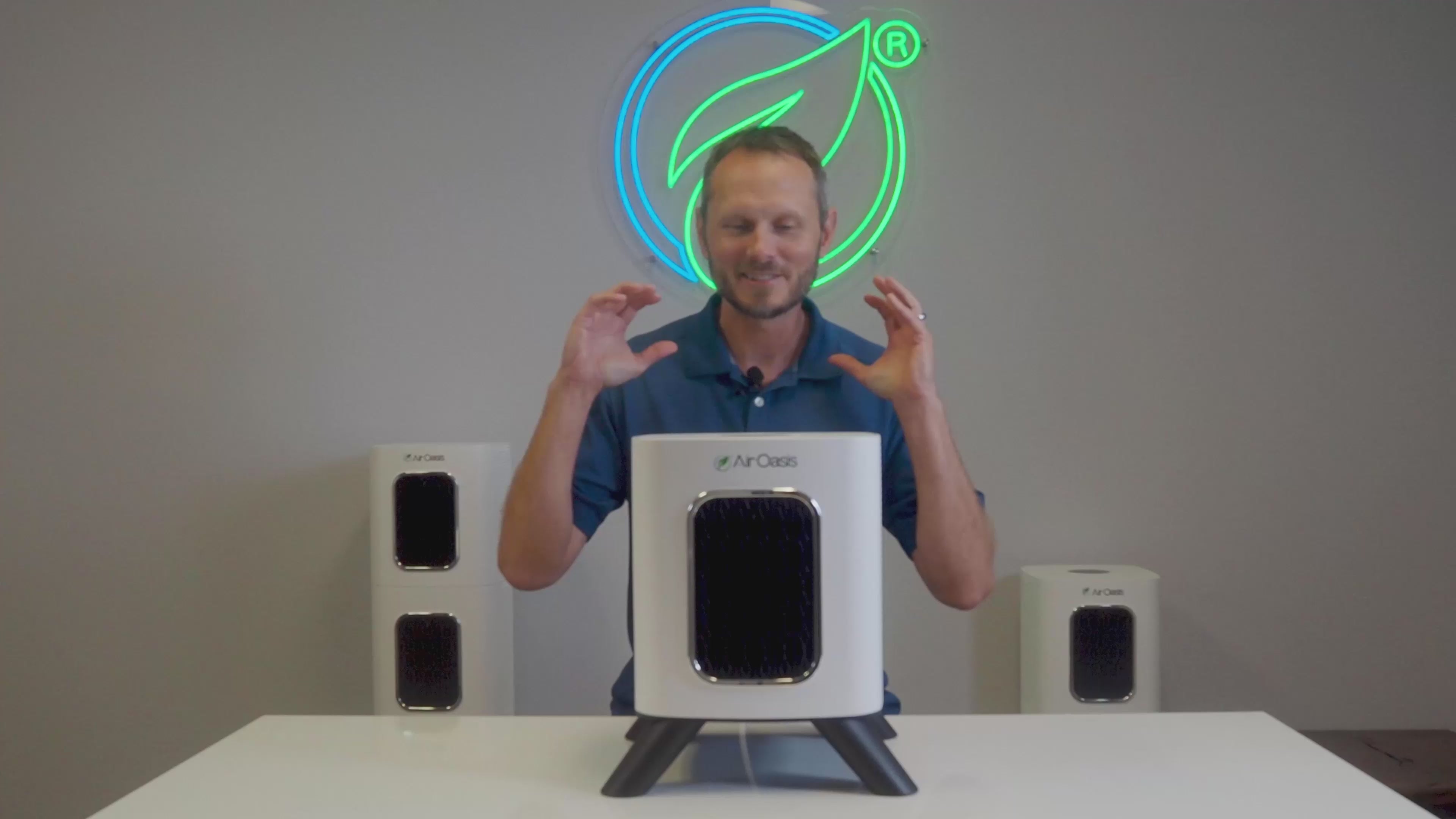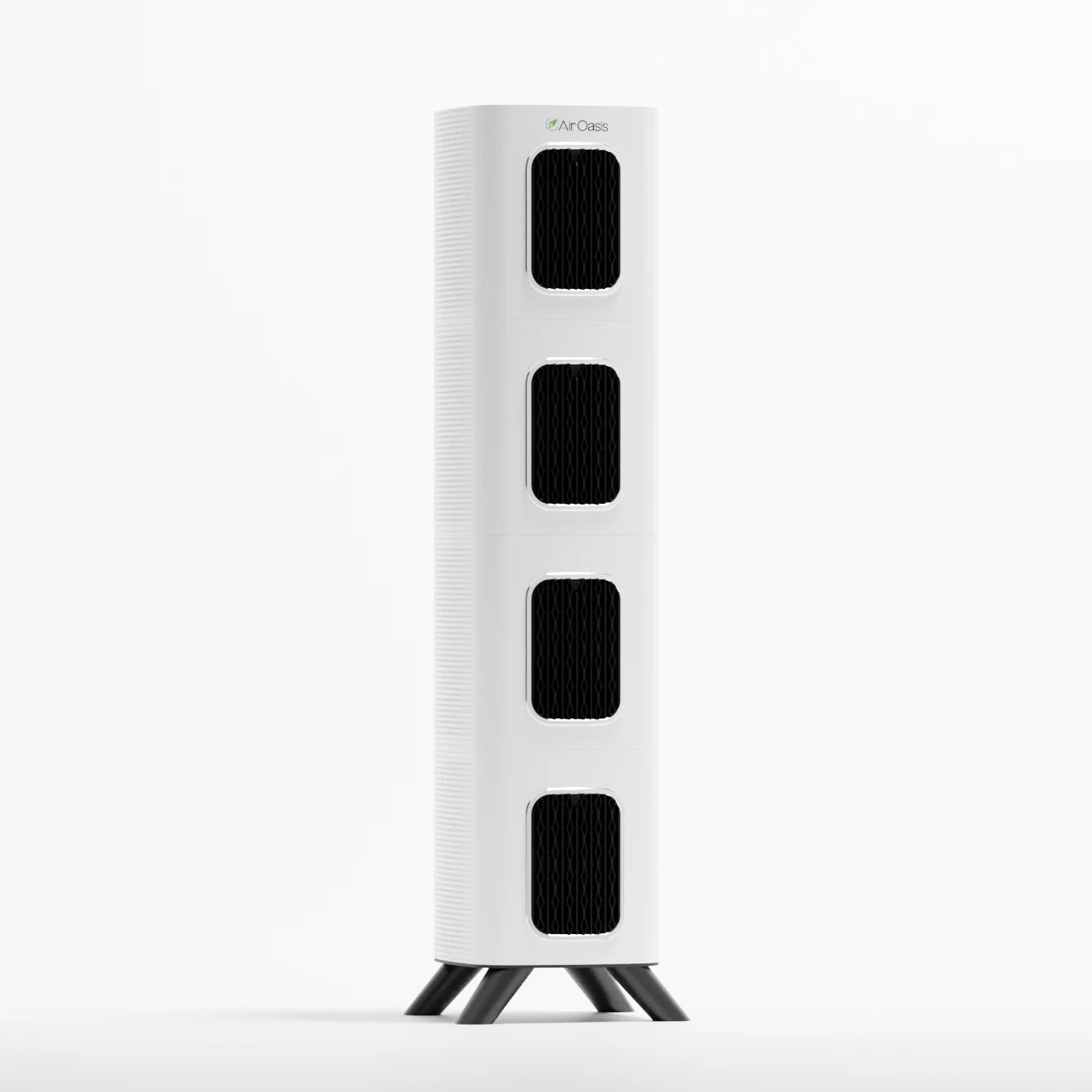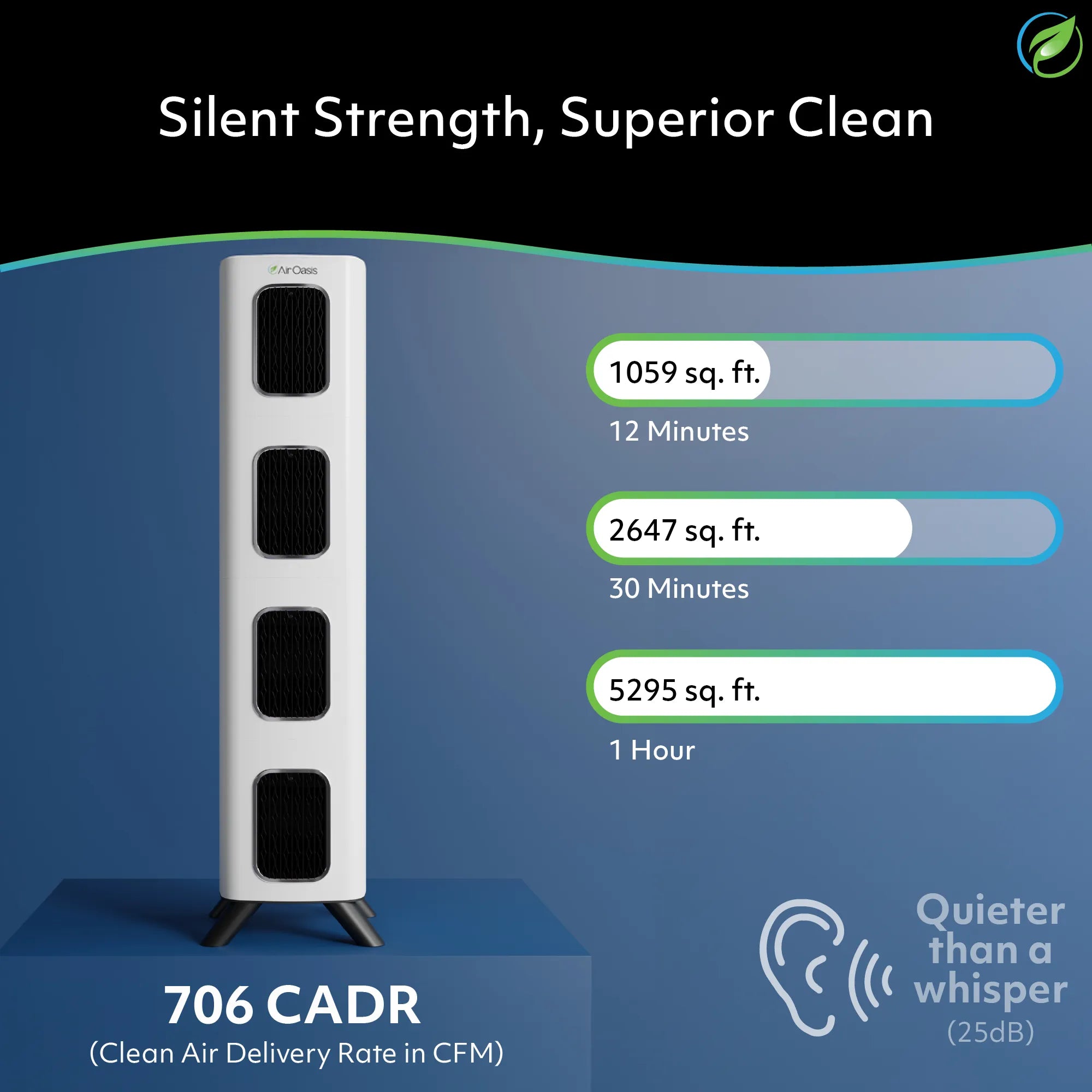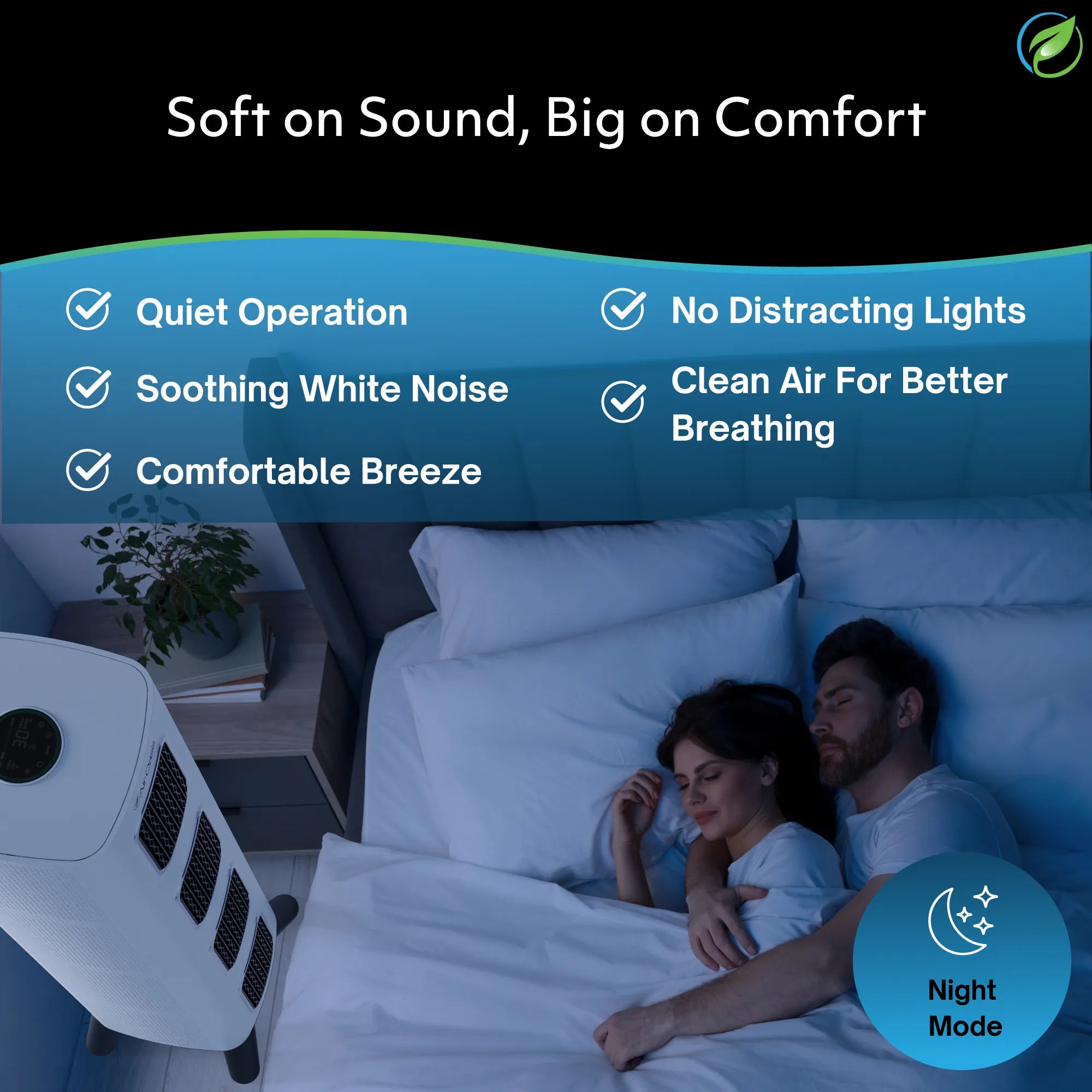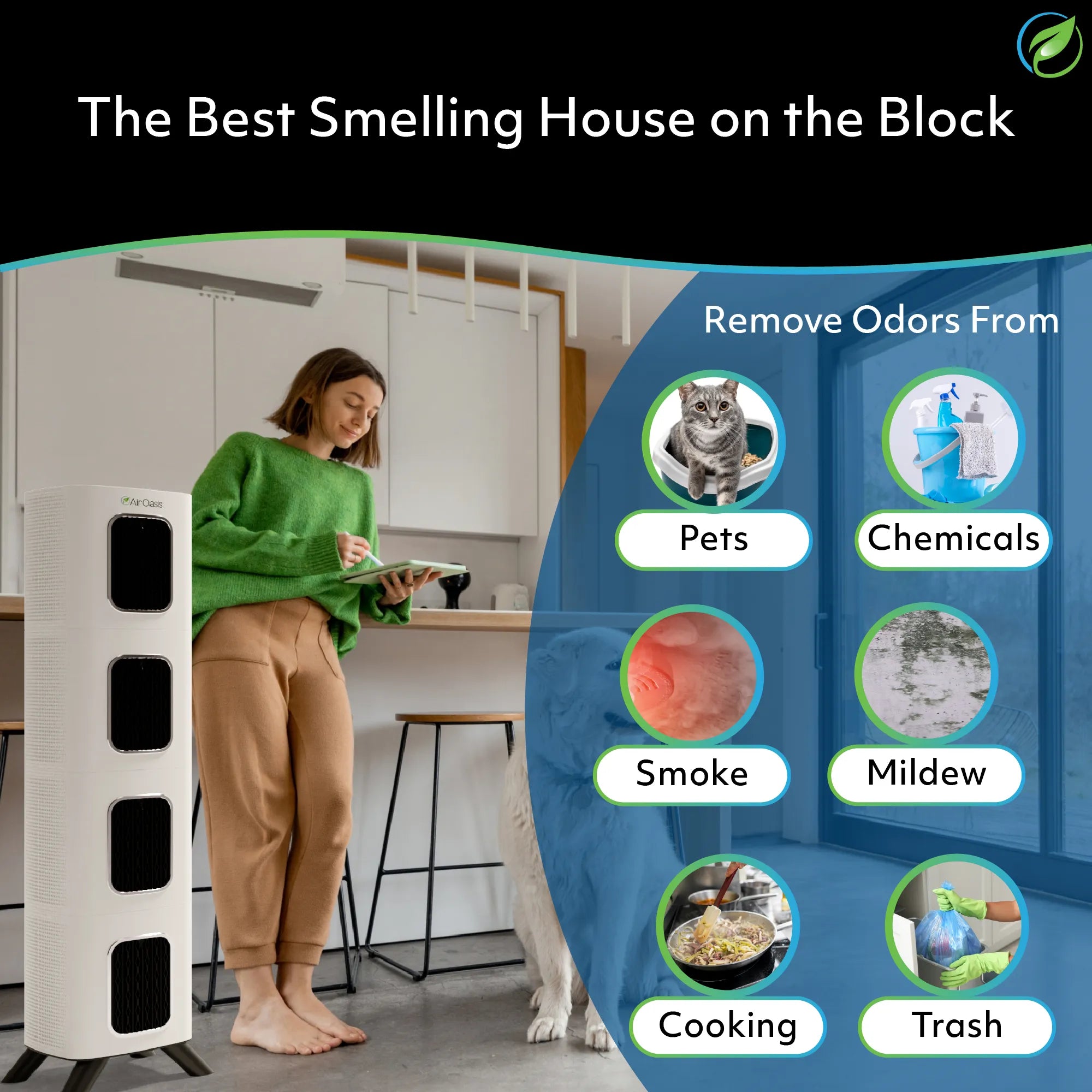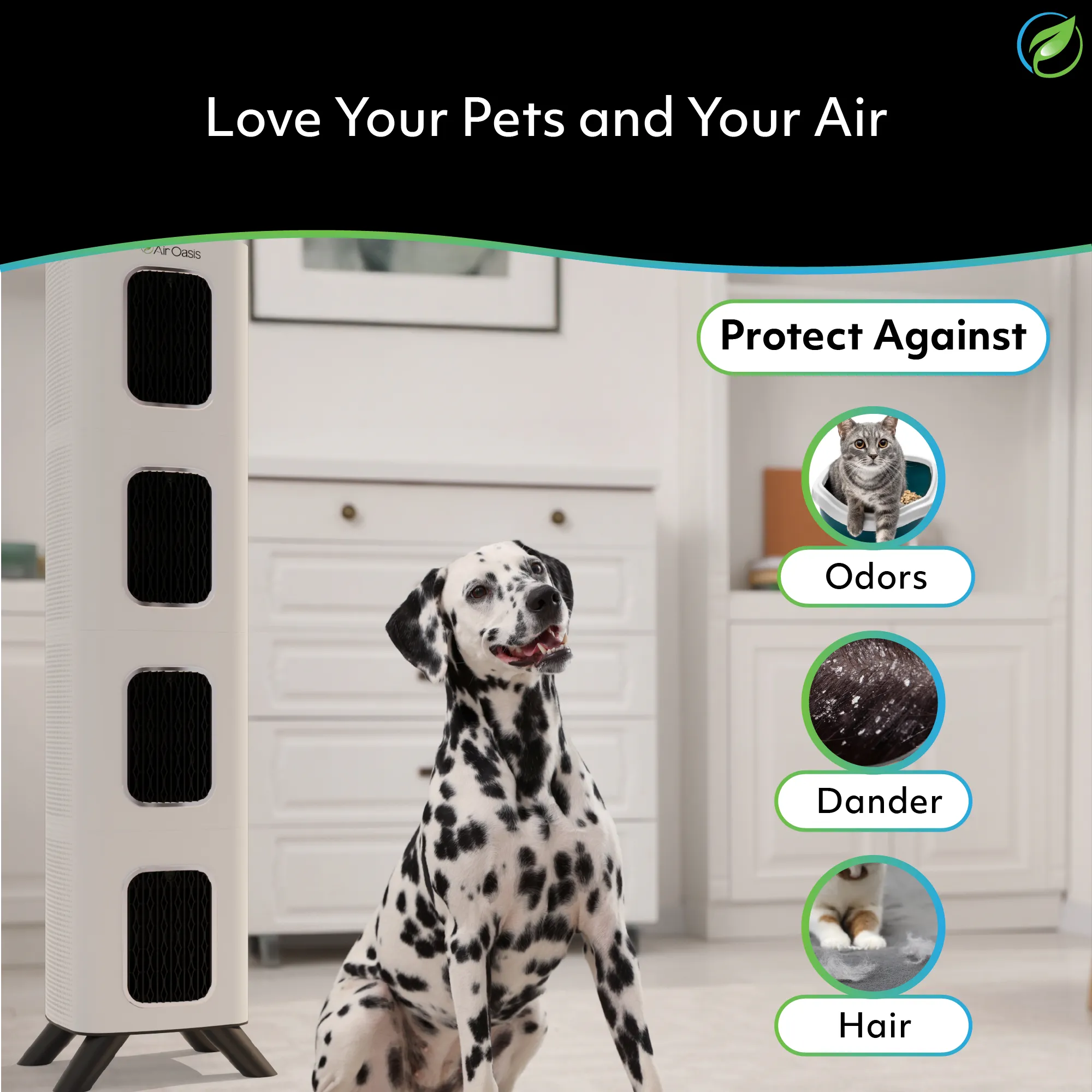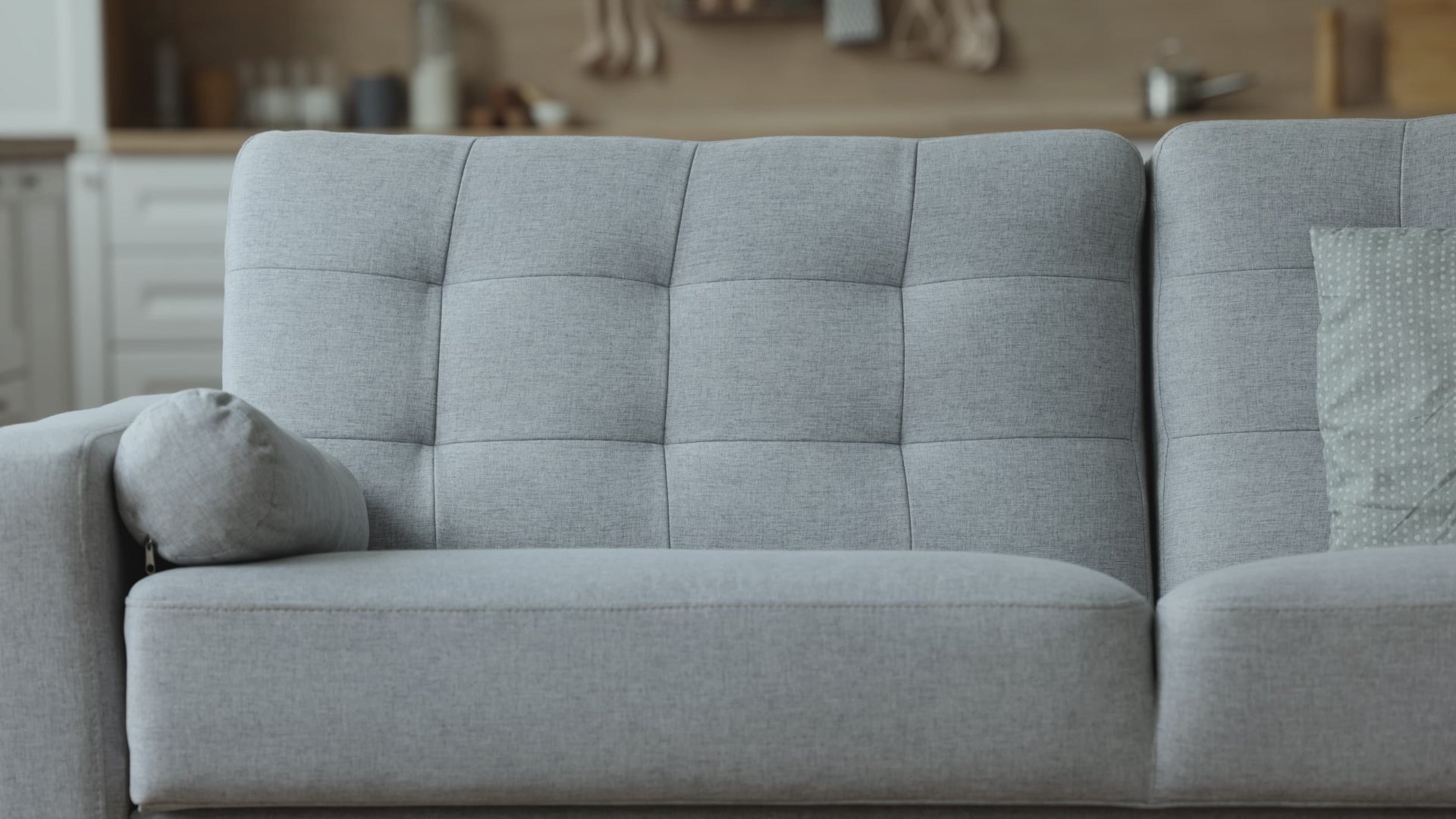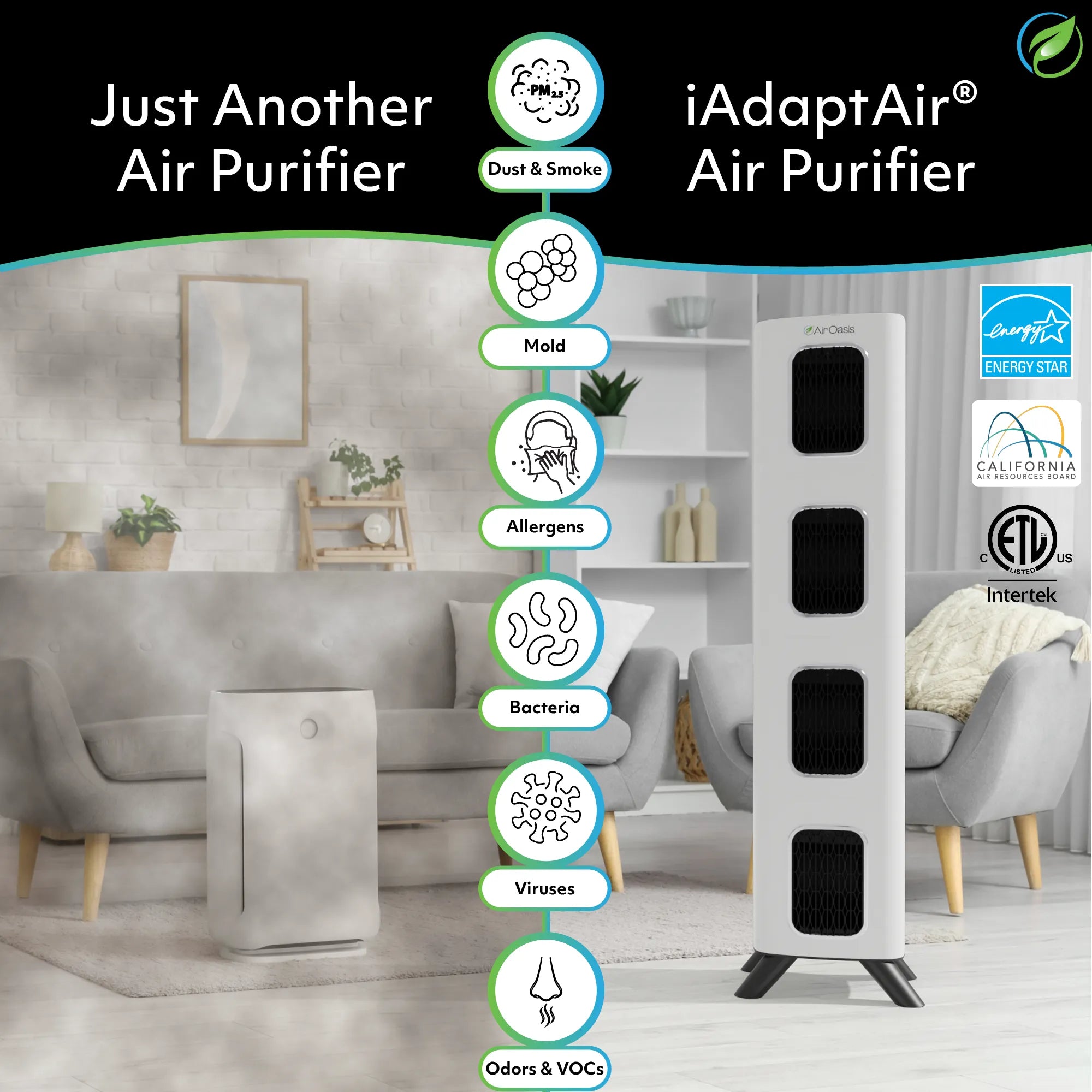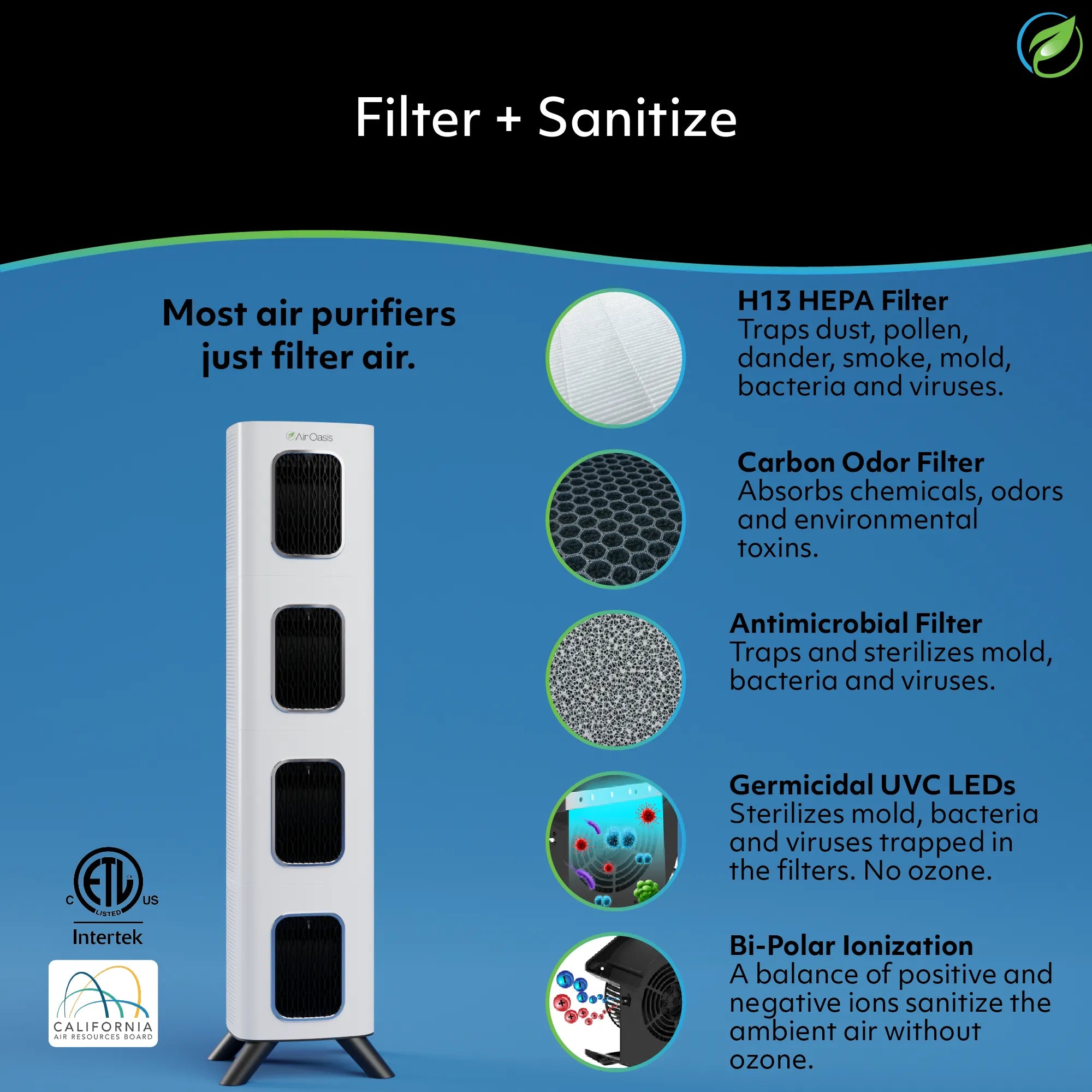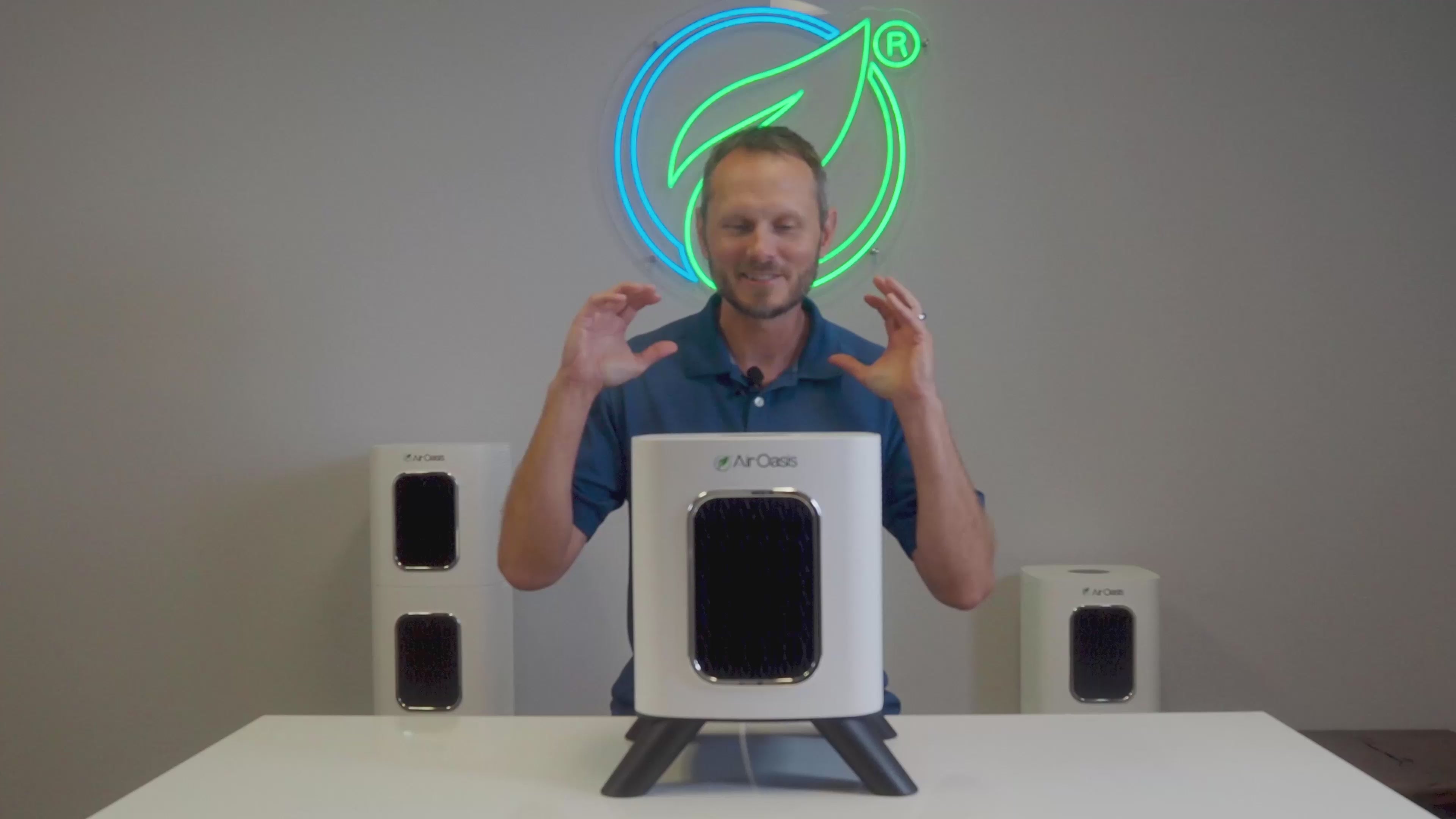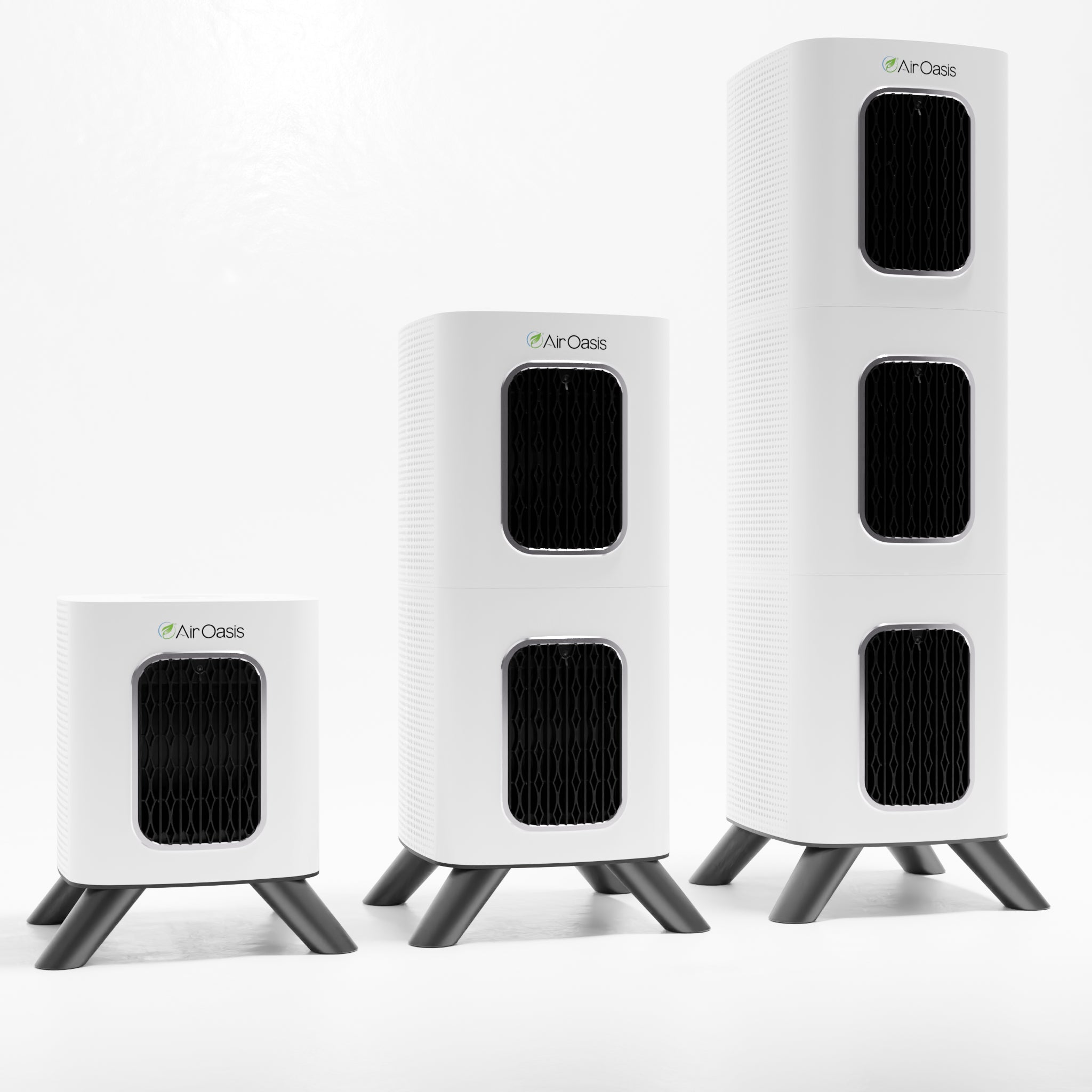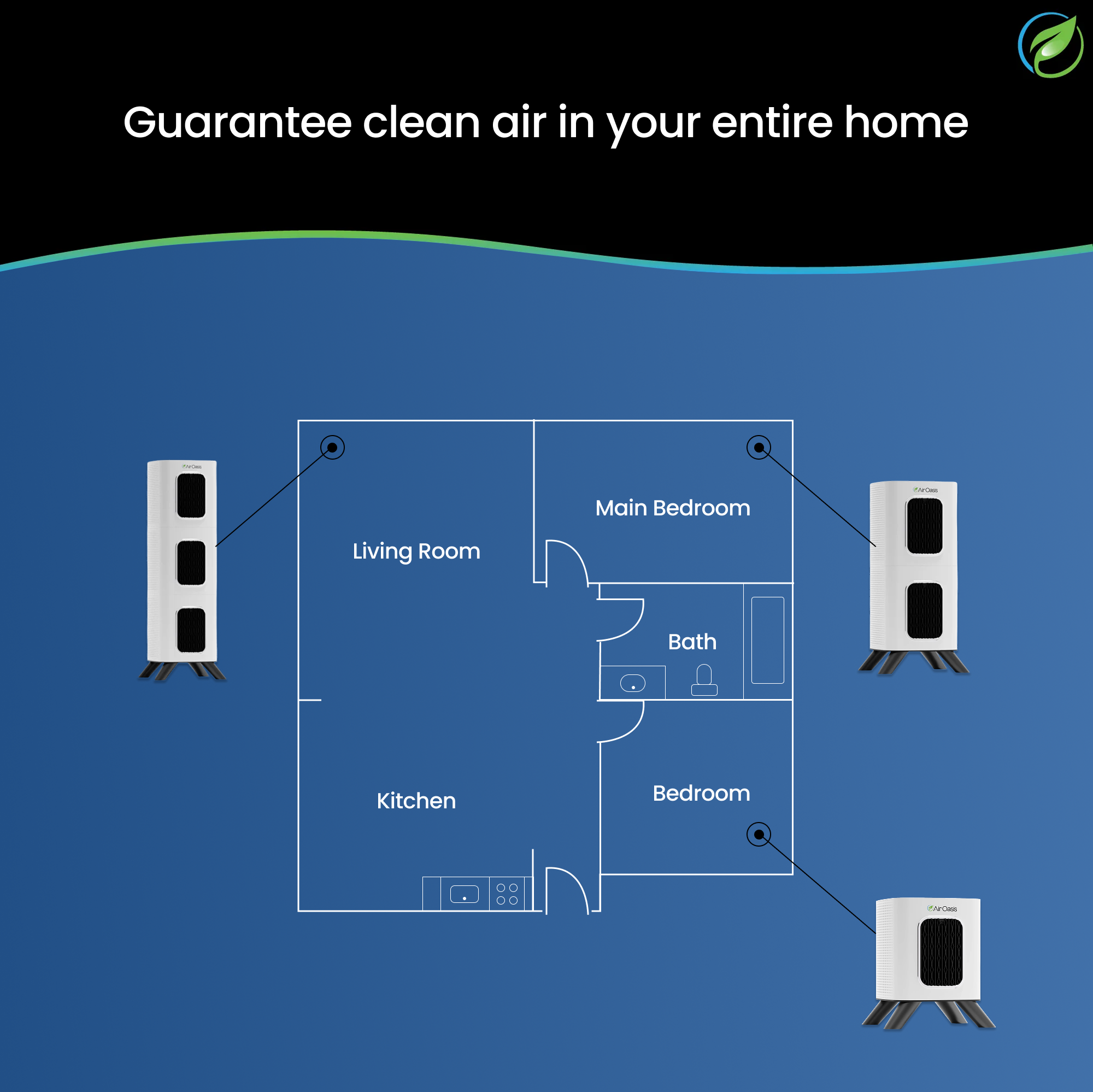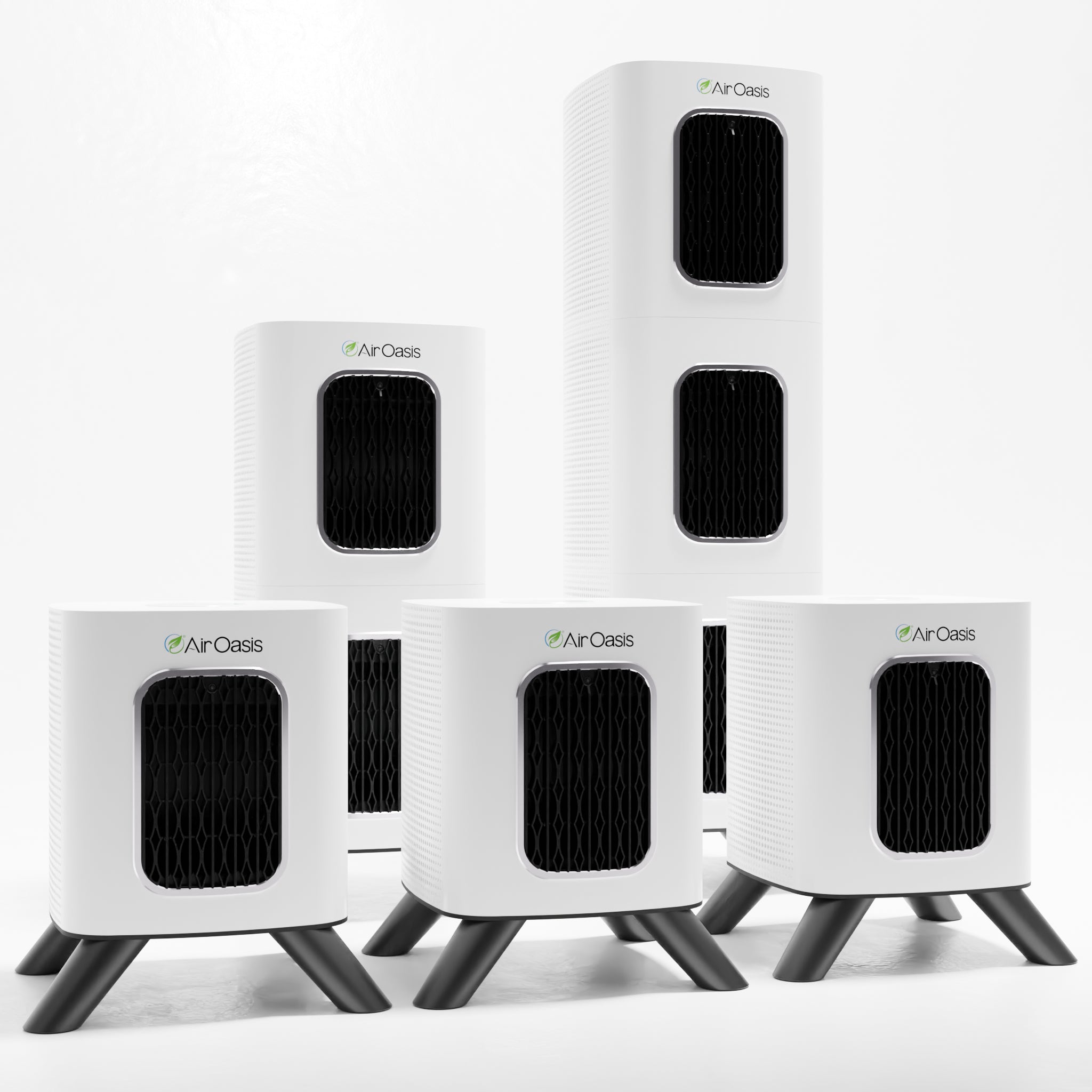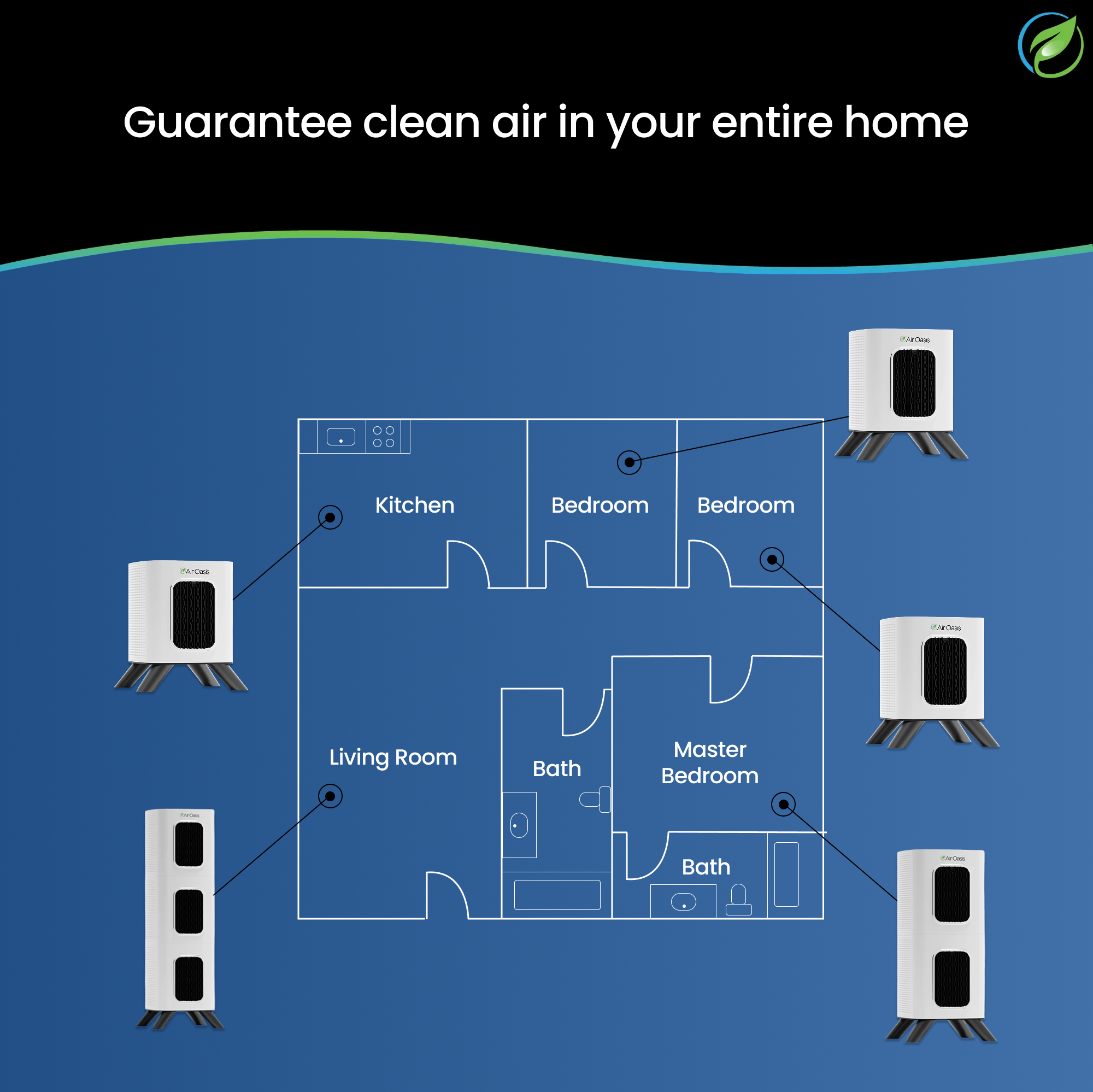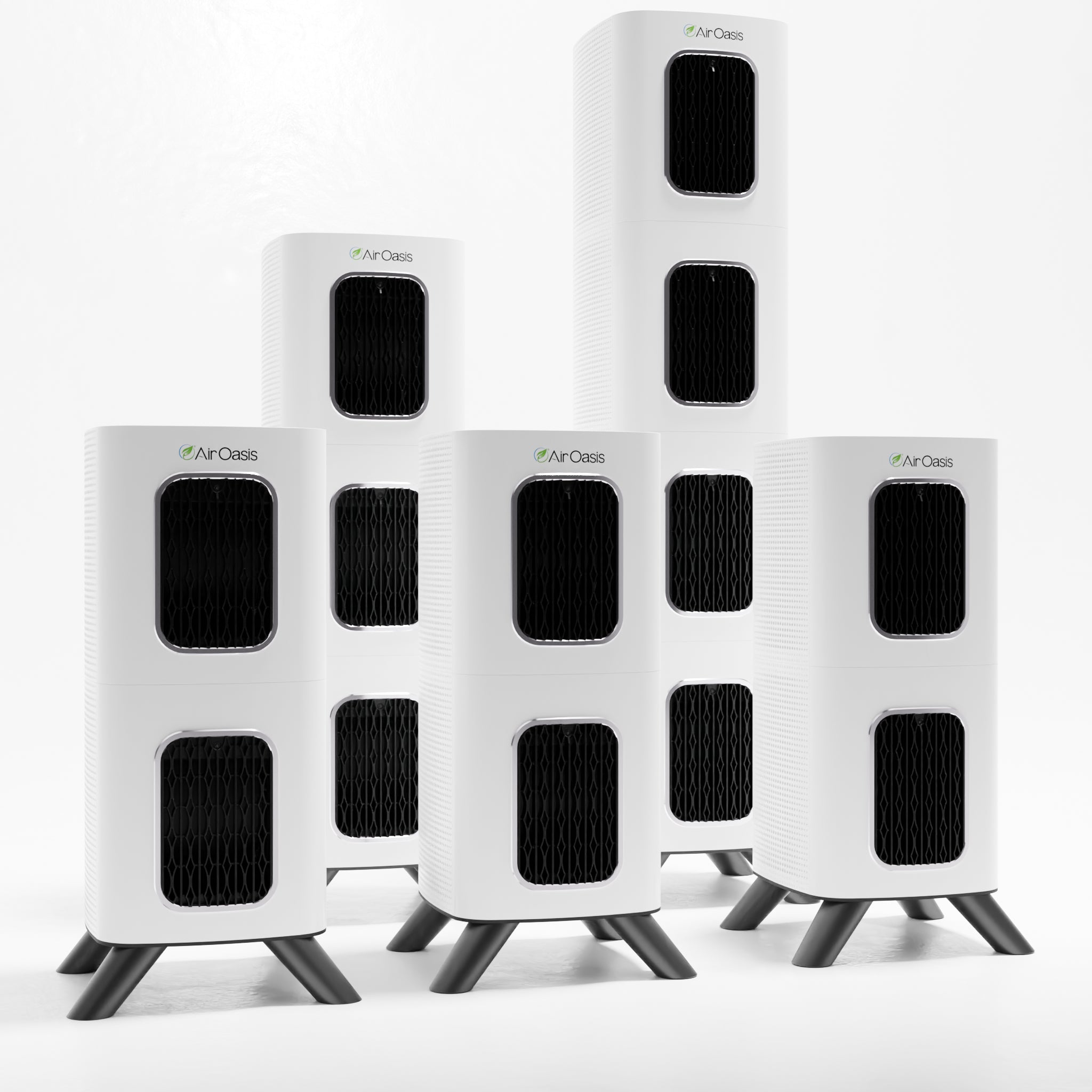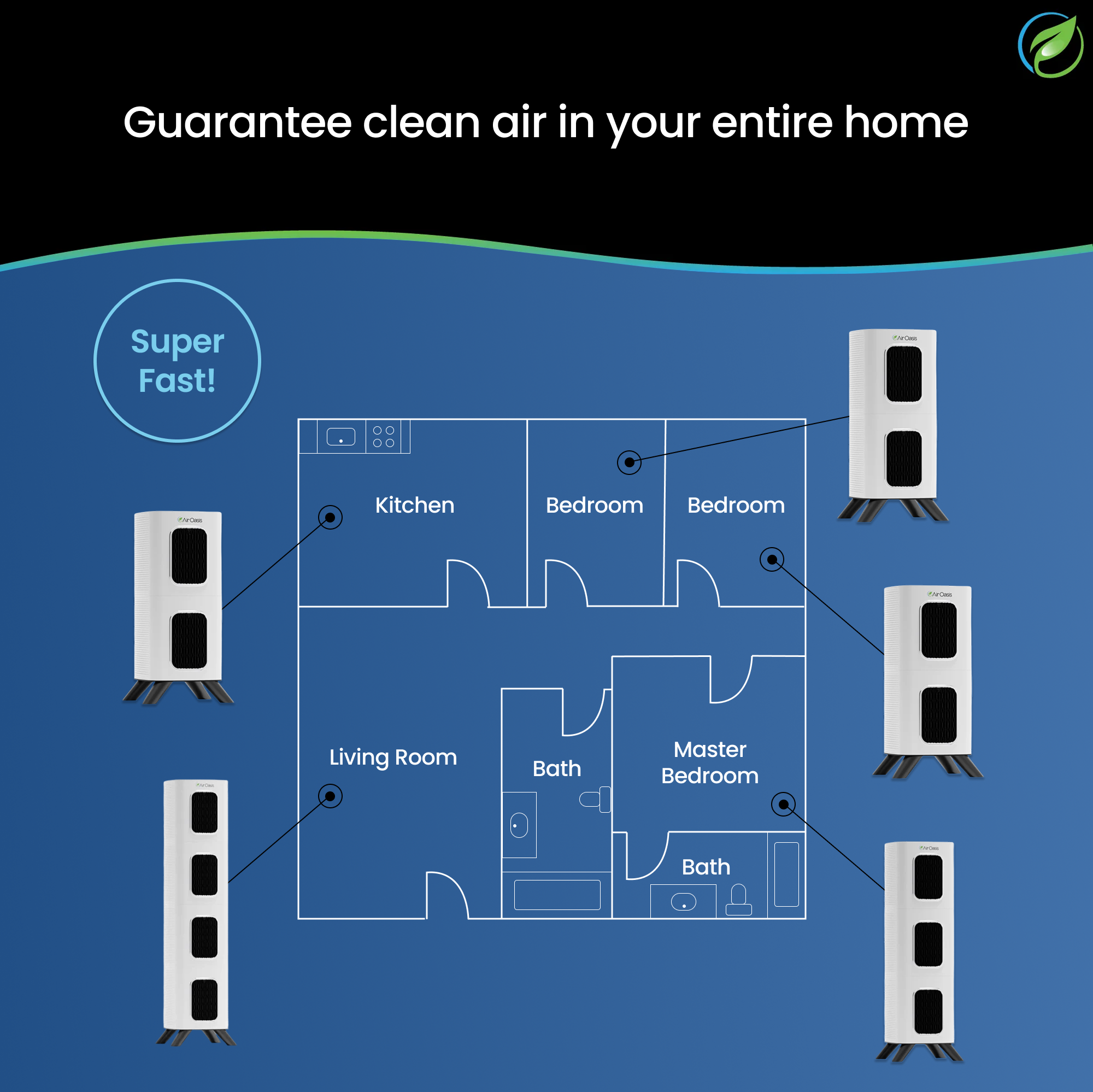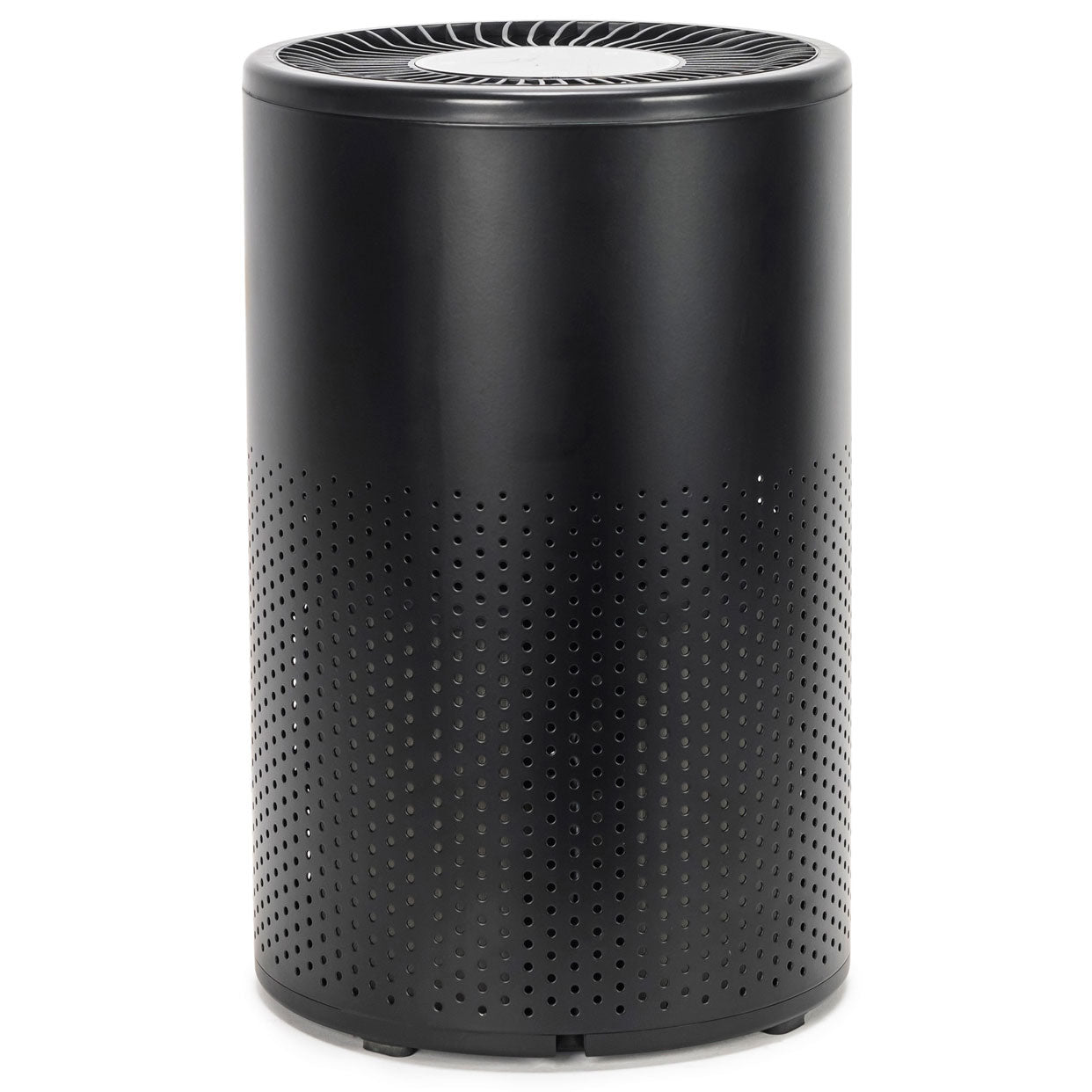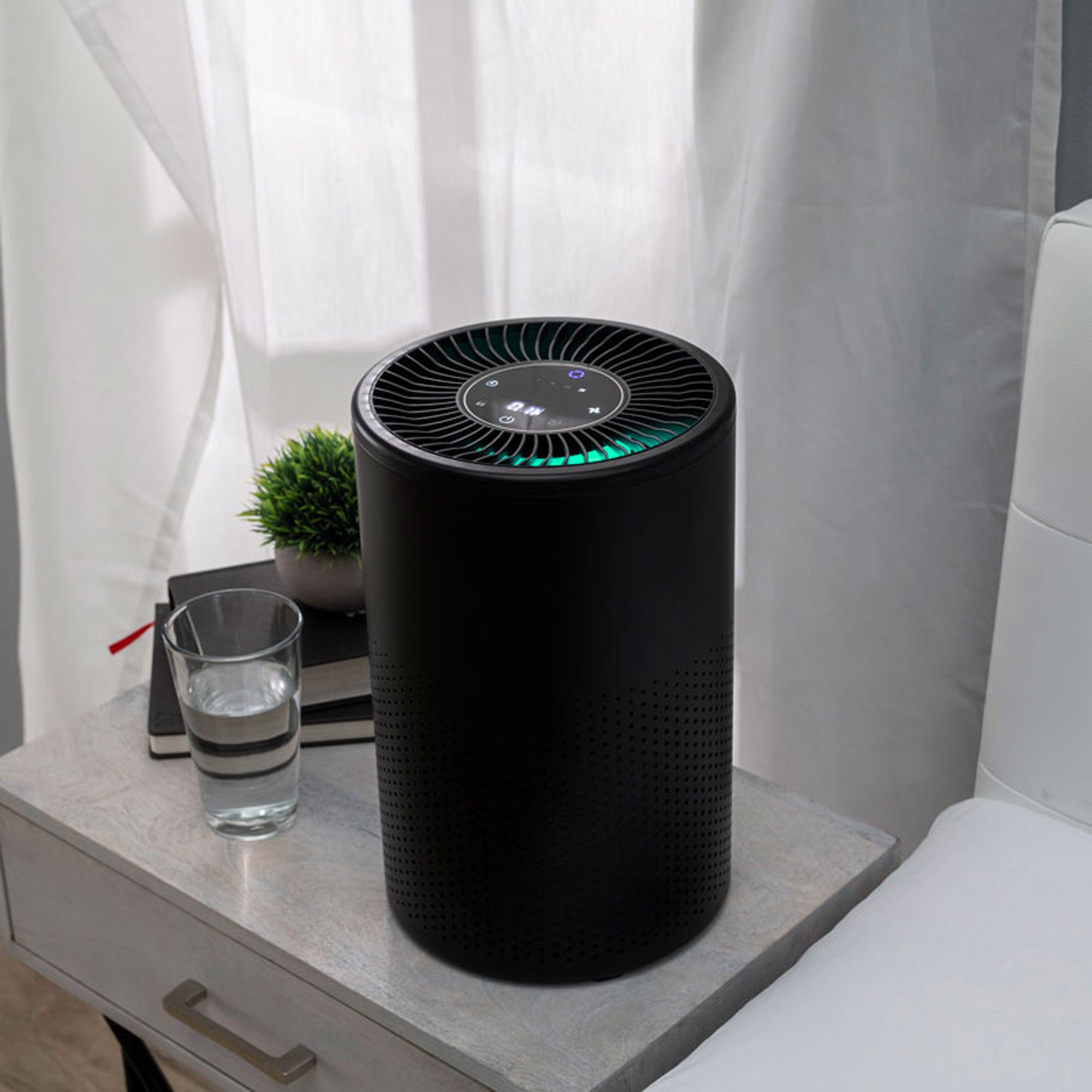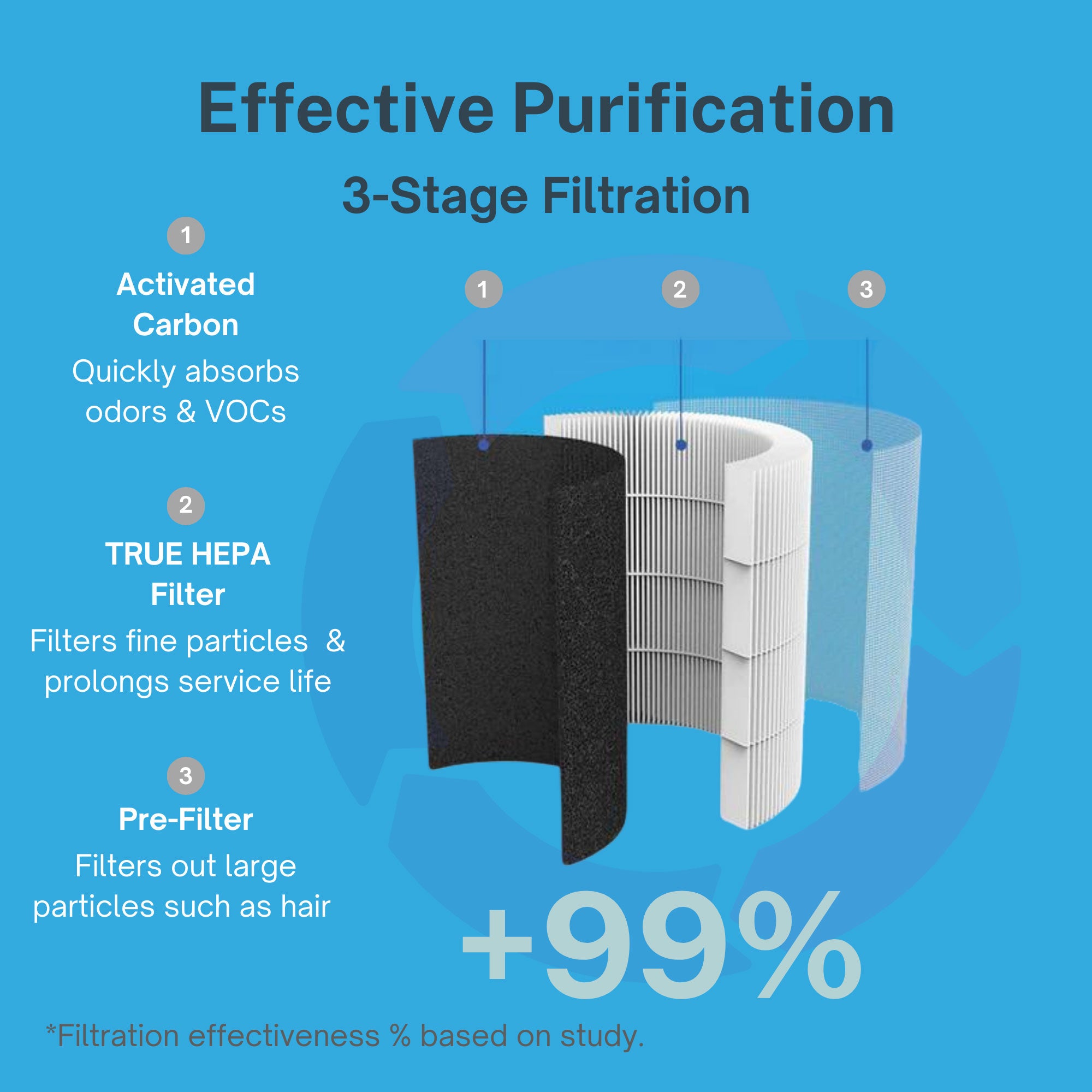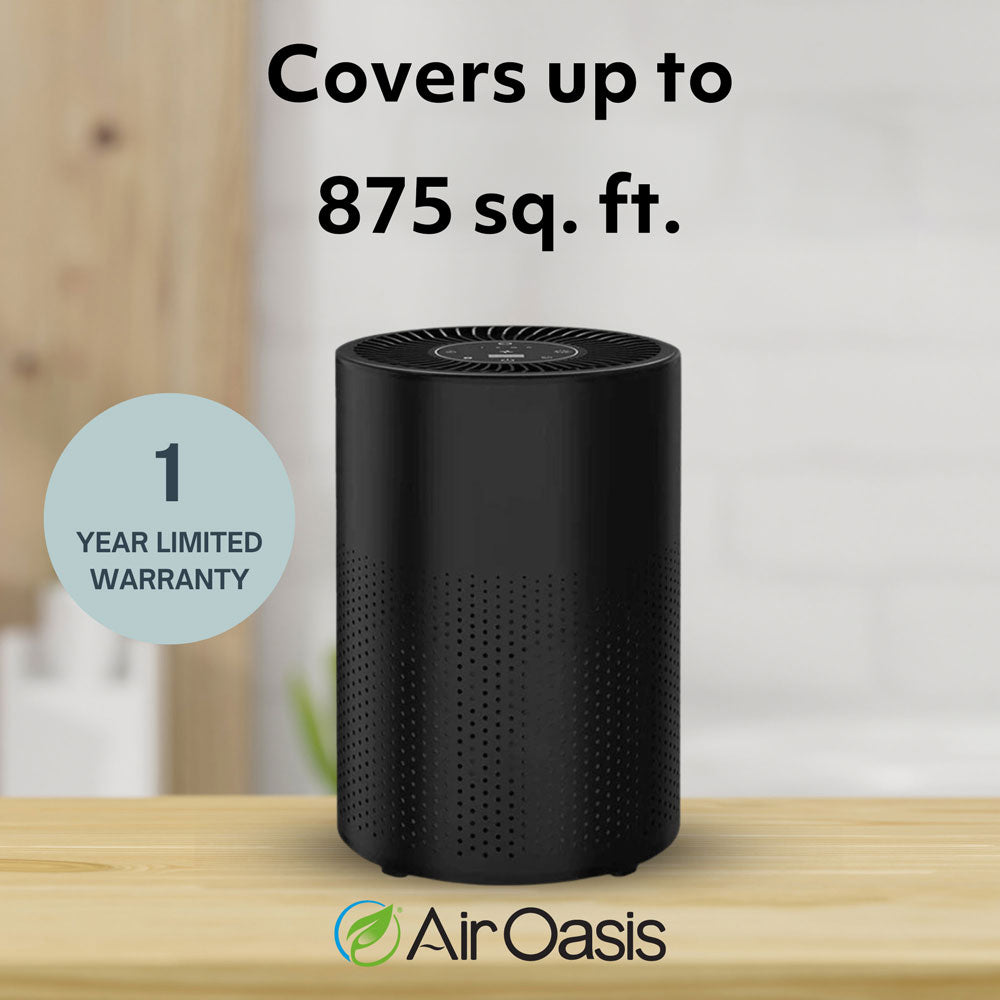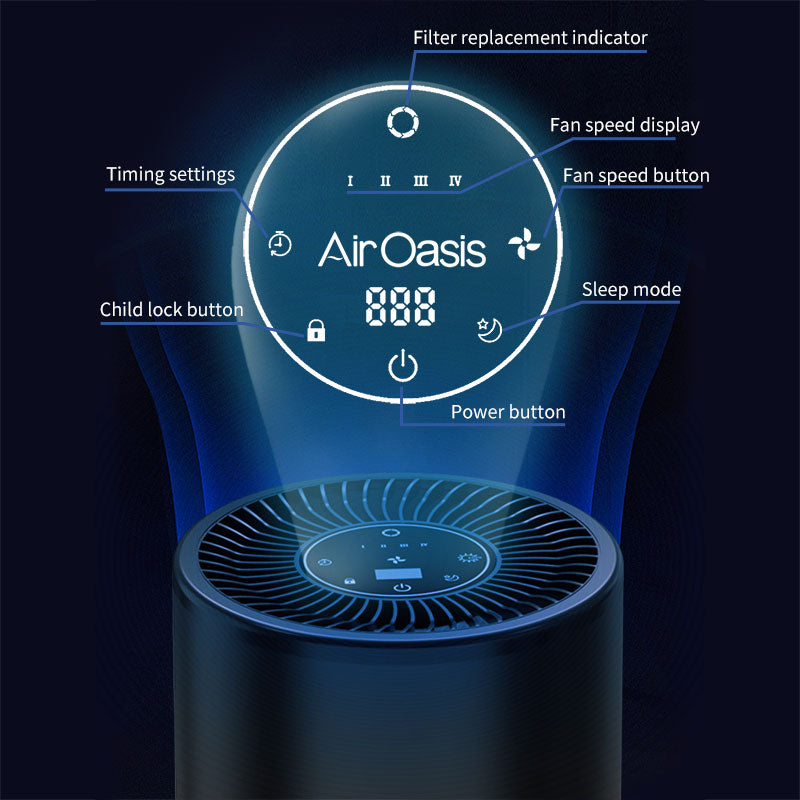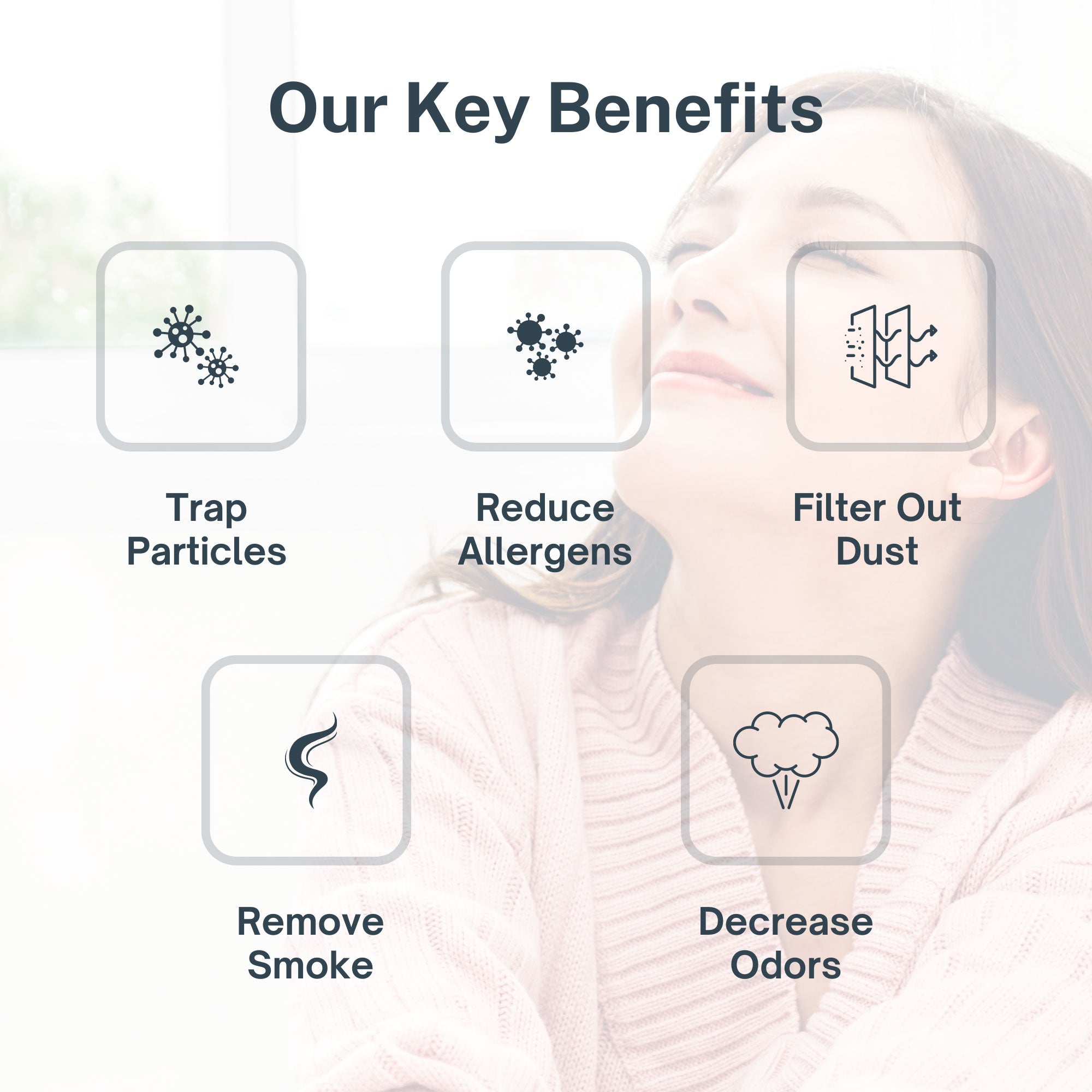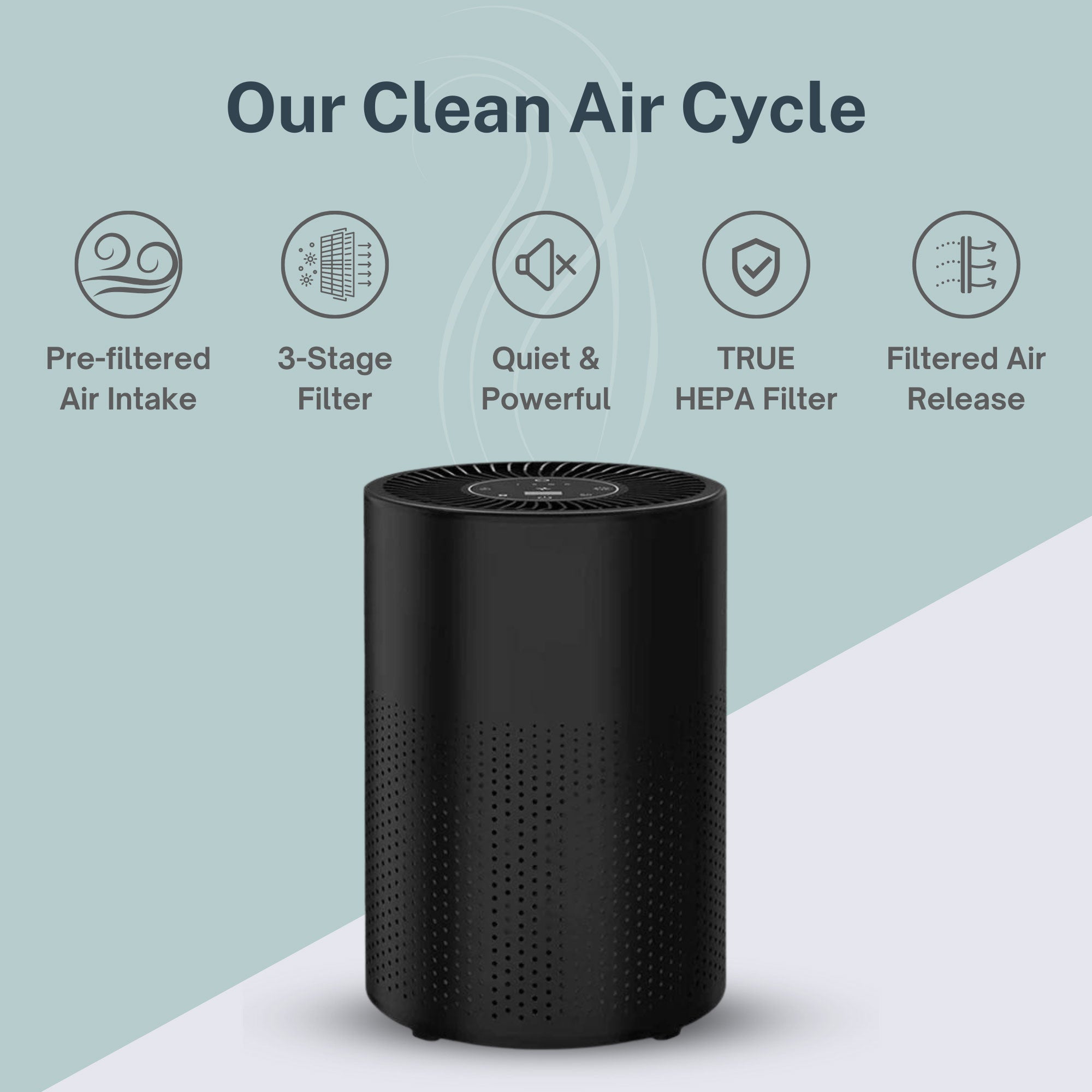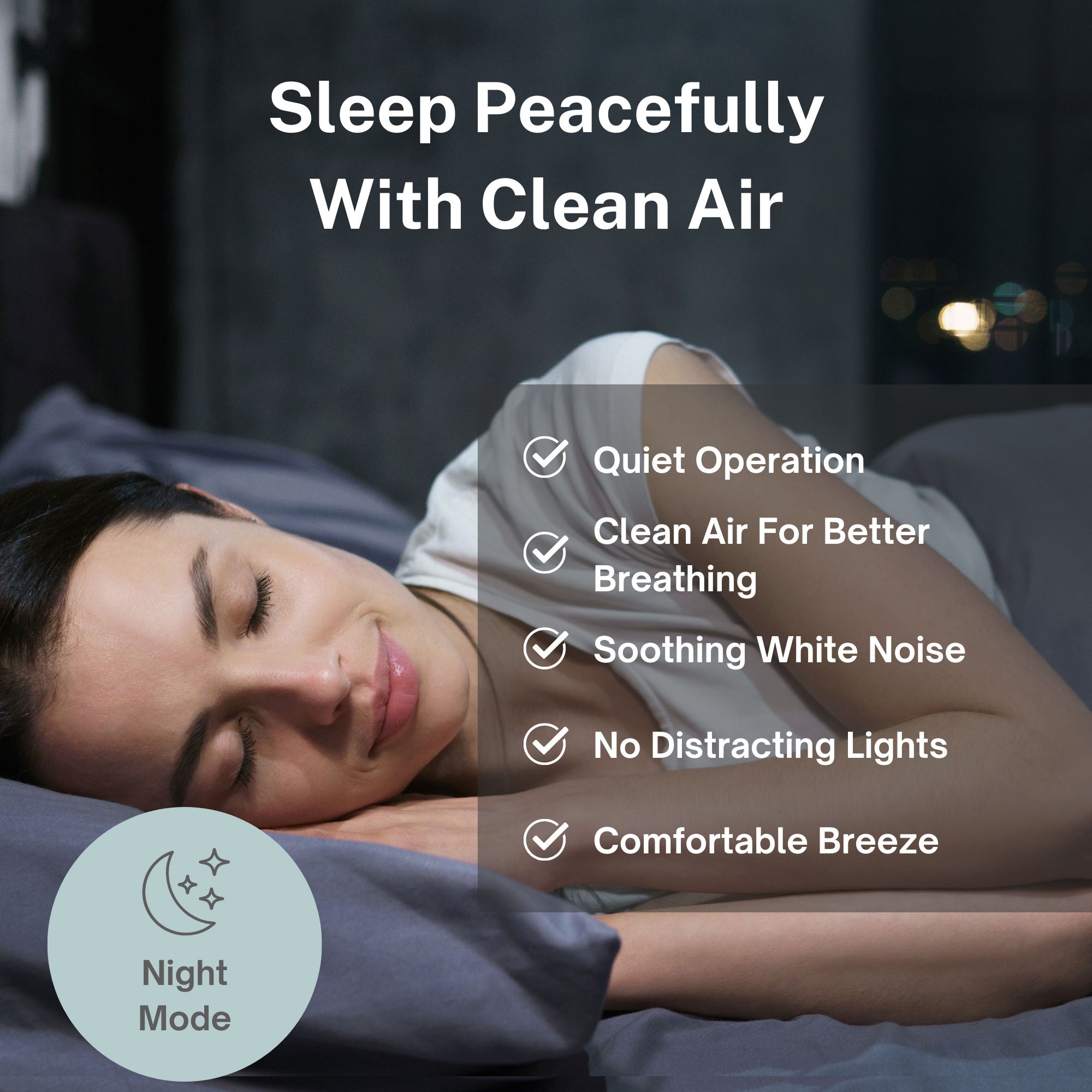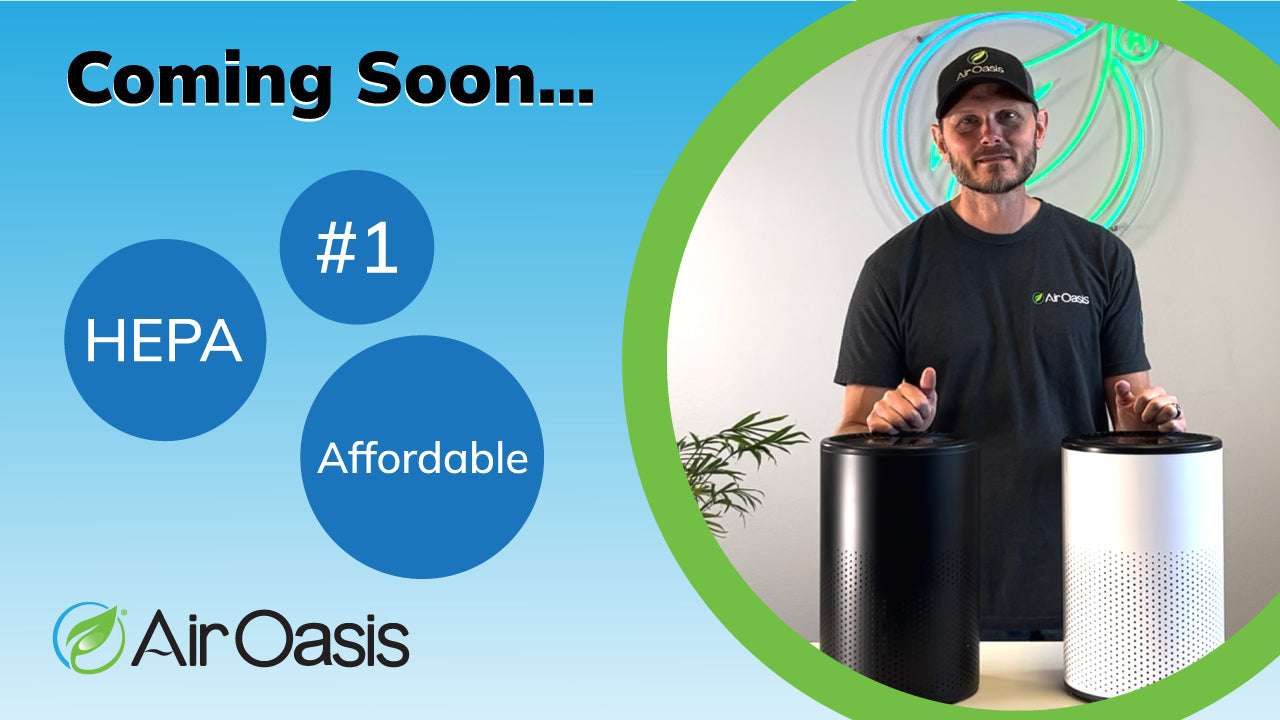Every home has some mold, including yours. Whether it actually grows and spreads is an entirely different issue, but the potential for mold growth is always there. It’s impossible to keep mold spores out of a home because they are ubiquitous in nature and can easily travel indoors, through vents, doors, windows and even on a person’s body. Luckily, most molds are relatively harmless.
However, there are a few indoor molds that pose significant health risks, and black mold is one of them. Although the health effects of toxic black mold exposure are widely debated, there is sufficient evidence that black mold in the home endangers every occupant. Whether or not someone has an adverse reaction depends on myriad factors.
If you suspect black mold growth (or any mold growth) in your home, you don’t have to be resigned to breathing spores or other dangerous byproducts. You can protect your lungs by running an air purifier for mold while you pursue remediation.
Keep reading to learn everything you need to know about how black mold works and how Air Oasis air purifiers can aid in your fight against indoor air contaminants.
Black Mold Basics
Many molds are black in color, but black mold refers to a specific variety called Stachybotrys chartarum. Although countless reports detail bizarre and severe reactions to black mold exposure, its toxicity remains a controversial topic. Feared by homeowners and allergy-sufferers world-wide, this particular microfungus is more infamous than any other indoor mold.
Characteristics of Black Mold
 Black mold is greenish-black in color that typically grows in small, thinly textured circles. From far away, black mold can appear to be a gray or black stain; up close, it can look fuzzy or speckled. Black mold is a dematiaceous fungus, meaning it is darkly pigmented and can cause a variety of infections in humans.
Black mold is greenish-black in color that typically grows in small, thinly textured circles. From far away, black mold can appear to be a gray or black stain; up close, it can look fuzzy or speckled. Black mold is a dematiaceous fungus, meaning it is darkly pigmented and can cause a variety of infections in humans.
Growth Requirements for Black Mold
Even though mold spores exist everywhere, both inside and outside, they only colonize in certain environments. Black mold spores require the following conditions to thrive:
- An extremely damp environment or water source
- High humidity, preferably more than 90%
- Cellulose-rich materials to consume
- Warmth
When black mold spores land on surfaces that fit this description, they grow. However, it’s important to note that black mold needs a constant source of moisture to keep growing. If a water source dries up, the mold colony will as well. Unfortunately, even dried-up mold retains its toxicity.
Where Does Black Mold Grow?
Black mold is slow-growing and does not compete well with other molds. It is rarely found in nature, although it is occasionally sampled in soil or grain. More often than not, black mold is found in cellulose-rich building materials in water damaged buildings. It can thrive in water-damaged fiberboard, drywall, wood, paper and ceiling tiles. If you’re searching for black mold in your home, search in places with high humidity, an active water source or water damage.
How Black Mold Spreads
Black mold spreads by releasing microscopic particles called spores. These tiny particles range from two to 100 microns in size and can travel large distances in the air. Eventually they fall, and if they land in a hospitable environment, they can colonize.
Many types of mold spores are readily airborne, but Stachybotrys chartarum only releases spores when its mold clusters are dry or physically disturbed. That’s because black mold colonies are generally covered in a layer of slime. However, they can and do become aerosolized; in fact, airborne black mold spores may exist in up to 13% percent of dwellings.
Dangers of Black Mold
Most molds can trigger an allergic reaction in people that have a mold allergy. One of the reasons that black mold gets so much attention is that in addition to allergic symptoms, black mold exposure has been linked to long-term illness, respiratory disease and neurotoxic effects. How dangerous a particular black mold colony is depends on the person exposed, the duration and severity of exposure and the byproducts released by the colony.
Inhaling Black Mold Spores
When you inhale black mold spores, a number of things can happen. If you don’t have a mold allergy and the spores don’t carry any toxic byproducts, you may not experience any health effects. Even if you do have a mold allergy, you may only exhibit symptoms similar to those produced by hay fever. However, if the mold spores are transporting other mold toxins, such as certain mycotoxins, you may experience neurological effects.
What Are Mycotoxins?
Mycotoxins are toxic chemicals produced by some fungi, including black mold. All molds are capable of producing mycotoxins, but not all mycotoxins are equally harmful to human health. A portion of black mold colonies produce a class of mycotoxins called macrocyclic trichothecenes, which are extremely dangerous and can cause neurotoxic effects. However, it’s impossible to say whether a particular black mold cluster is releasing these chemicals without lab testing.
Exposure to certain trichothecene mycotoxins can cause a vast array of symptoms in animals and humans. Research suggests that dermal exposure to some trichothecene mycotoxins can lead to burning, redness and blisters; oral exposure can cause vomiting and diarrhea; and inhalation may cause nasal irritation and cough. All routes of exposure can cause systemic symptoms, including weakness, ataxia, hypotension, coagulopathy, and even death.
Microbial Volatile Organic Compounds
One of the tell-tale signs of mold growth is a musty, stale or earthy smell. These smells are produced by microbial volatile organic compounds (mVOCs), chemical gasses released by all fungi. Many molds release mixtures of alcohols, aldehydes, acids, ethers, esters, ketones, terpenes, thiols and their derivatives.
Although mycotoxins get most of the credit for causing toxicity in humans, there is evidence to support the idea that mVOCs may contribute to the problem. In fact, some experts believe mVOCs may cause many of the symptoms associated with sick building syndrome, including headache, eye, nose, and throat irritation, dizziness, nausea, and difficulty concentrating.
Is All Black Mold Toxic?
All black mold has the potential to trigger allergy symptoms in people who are allergic, but not all black mold is toxic. Whether or not a black mold colony is toxic depends on which mycotoxins and mVOCs it releases into the air. This distinction is one of the reasons there’s so much controversy surrounding black mold’s health effects.
Who Is Affected by Black Mold?
Regardless of whether a particular mold colony produces dangerous airborne chemicals, certain individuals are at a higher risk for health complications. Breathing black mold is generally more dangerous for the following groups:
- People with allergies
- People with underlying lung disease
- Individuals with chronic respiratory disease
- Asthmatics
- The elderly and infants
Additionally, individuals who have poor nutrition, a weakened immune system, low detox capability and comorbid illness are more likely to experience adverse reactions. However, anyone may experience negative health effects when exposed to toxic black mold over time.
Exposure to Black Mold
When considering the complexity of each person’s immunological response to mold antigens and the variance in a particular mold cluster’s byproducts, it’s easy to understand why the same variety can produce vastly different health effects. When considering the role that exposure plays in sickness, it’s important to include severity and duration.
Brief, Mild Exposure
As with any other toxic substance, the less time you spend with black mold, the better. People who encounter only small doses of toxic black mold particles for a brief time are less likely than people who experience prolonged exposure to experience severe symptoms. More often than not, people who are only briefly exposed to low doses of black mold don’t even notice. If they do display symptoms, it’s generally in the form of an allergic reaction.
Brief, Acute Exposure
Brief, acute exposure to toxic black mold would involve inhaling a large dose of toxic mold in a short amount of time. The effects could range from lung irritation and wheezing to cell death, inflammatory response, loss of balance and coordination, memory loss, delirium and more. Brief exposure, even when acute, is more likely to trigger neurological and neurotoxic effects than to cause chronic illness associated with long-term exposure.
Prolonged Exposure
Prolonged exposure to any mold or dampness is dangerous and can contribute to a condition known as sick building syndrome (SBS). SBS is a complex spectrum of conditions and symptoms that arise in response to spending lots of time in an affected building, such as a moldy workplace. Buildings that cause SBS generally have poor indoor air quality and environmental controls, as well as dampness and fungal growth.
Individuals who are chronically exposed to black mold may develop mold sickness that mirrors flu symptoms, including sore throats, diarrhea, headaches, fatigue, dermatitis and hair loss. Black mold mycotoxins can suppress the immune system, making a person vulnerable to opportunistic infections and other conditions.
Sicknesses Caused by Black Mold
Toxic black mold is associated with many negative health consequences, but whether or not someone develops sickness depends on case-specific factors. Removing yourself from the mold source is typically the best way to find relief. However, some mold-related illnesses continue or develop even after a person is no longer exposed to black mold.
Black Mold Allergies
If you’re allergic to black mold, being around it can make you feel sick. You may experience symptoms like headache, sneezing, runny nose, red eyes, skin rash, lung irritation and wheezing. Breathing black mold is especially dangerous for asthmatics, as even non-toxic molds can trigger asthma attacks. Removing the mold from your living and working environment is generally the best way to control symptoms.
Mold Toxicity
When you interact with toxic black mold, you risk black mold poisoning. Exposure to certain mycotoxins can cause serious neurotoxic, neurological and neuropsychiatric effects. Symptoms may include cognitive impairment, brain fog, vision changes, confusion and loss of balance. If you enter a noticeably moldy building and begin to feel any of these symptoms, it’s a good idea to leave immediately.
Can Black Mold Cause Chronic Illness?
People who experience ongoing symptoms after mycotoxin exposure may develop chronic inflammatory response syndrome (CIRS). Acute mycotoxin exposure may trigger the immediate onset of symptoms like headache, nosebleed, nasal congestion, cough, flu-like symptoms, shortness of breath and gastrointestinal issues. Although many people will recover with proper treatment, others will not. CIRS is just one of the chronic illnesses they may develop.
Unfortunately, removing yourself from a mold-infested building may not be enough to protect against future illness. According to a 2014 study, a person’s sinuses can continue to harbor mold particles even after they’ve left a moldy environment. Even from inside the sinuses, a mold may continue to release mycotoxins, prolonging the carrier’s exposure and increasing the risk for developing chronic illness.
In addition to CIRS, toxic mold exposure has been linked to debilitating illnesses like chronic fatigue syndrome, chronic fungal rhinosinusitis, hypersensitivity pneumonitis, acute neutrophilic rhinitis, new-onset asthma and a host of other chronic and respiratory diseases.
When to Test for Black Mold
If you suspect black mold is growing in your home, it’s important to start investigating right away. Luckily, testing for black mold is easier than ever before. Not sure whether you need to? It’s a good idea to test for black mold in the following situations:
- You recently experienced flooding or a water leak.
- You live in an area with high humidity.
- You’ve noticed a musty smell recently.
- You’re having allergy symptoms for the first time.
- You’re about to buy a new home.
If you’ve already found a black mold colony in your home, there’s no need to conduct a test — you already know it’s there. However, you may want to run a test to confirm it’s actually Stachybotrys chartarum and not some other darkly colored mold.
Testing for Airborne Black Mold
When you want to test for airborne black mold, you don’t have to start with professional testing. You can start small with a DIY testing or air sampling kit. If you fail to get results or doubt the tests’ accuracy, then you can move on to more expensive services.
DIY Testing Kits for Black Mold
DIY testing kits are a fast and affordable way to find out if you have airborne mold. Plus, you can purchase them from online retailers and most large hardware stores. Before you buy one, you need to make sure that it can detect the presence of Stachybotrys chartarum in the air, not just on surfaces.
Air Sampling Kits for Black Mold
Indoor air sampling kits are a mid-tier option that allow you to sample the air and send off the samples to a professional laboratory for testing. These kits generally include everything you need to collect the samples, including an air pump and containers. After collecting the samples, you simply mail them to the lab and await results. One advantage this method has over DIY testing kits is that it will measure the concentration of airborne mold particles.
Professional Black Mold Testing
If you want to avoid any inaccuracies of DIY or sampling kits, you may want to go with professional black mold testing services. However, it’s important to note the Environmental Protection Agency (EPA) does not certify mold inspectors, so you’ll need to ask about qualifications and adequately vet a company before agreeing to their services.
The advantage to professional mold testing is accuracy and a more detailed analysis. However, even professional services are somewhat limited in their scope. Most tests will only detect the presence of airborne mold spores and some of their particles — not mycotoxins and mVOCs.
Black Mold Remediation
If you do find black mold in your home, it’s essential to address it with the proper remediation. Just be aware that depending on the extent of the mold damage, you may be looking at an expensive, time-consuming process. Mold eventually eats away at the material it grows on, and every surface that’s been touched by black mold growth will need to be replaced.
Who Should Clean Up Black Mold?
When you find mold damage, the first thing you’ll need to determine is who should clean it up. According to the EPA, if the moldy area is less than 10 square feet, you should be able to tackle the cleanup by yourself. However, if your home has experienced significant water damage or the affected area is much larger than 10 square feet, you may want to consider mold remediation services.
Additionally, if the water damage in your home was caused by sewage or you suspect the HVAC system may be contaminated with mold, you may need professional assistance removing it. Failing to remove all the material that mold has touched as well as remedying the moisture problem will result in fast recolonization.
How Do Air Purifiers Help with Mold?
One of the best things you can do to protect yourself from inhaling mold is to run a high-quality air purifier for mold. Air purifiers can help protect you and your family at every stage in the process: investigation, remediation and prevention.
It takes time to determine whether you have black mold growth in your home, and an air purifier can reduce the mold particles in the air while you gather more information. If you do find black mold, an air purifier can capture, reduce and destroy mold particles that are released into the air as you remove it. Finally, after you’ve finished remediation, an air purifier can help you prevent recolonization by continuing to remove any lingering or new mold spores in the air.
Air Purifiers for Black Mold
Air purifiers help with mold in a number of ways, depending on their purification abilities. To be truly effective, air purifiers for mold should employ more than one method of cleaning the air. The most effective systems will utilize the top five air purification technologies.
1. True HEPA Filtration
When it comes to filtration, true HEPA filters are the gold standard. Unlike cheaper, more porous filters, HEPA filters have a strong, tightly woven mesh that is capable of trapping even tiny particles and allergens. Although HEPA is a must-have feature for many reasons, it’s important to be careful when removing filters that contain potentially hazardous contaminants.
2. Activated Carbon Filtration
Although HEPA filters are ideal for small particles and allergens, nothing gets rid of volatile organic compounds (VOCs) and musty mold odors better than carbon filtration. Carbon filters are adept at trapping odors and gasses and can work well at various temperatures and humidity levels. They are the best way to reduce VOCs, including mVOCs produced by black mold.
3. Bi-Polar Ionization
Bi-polar ionization, which is also called cold-plasma ionization, is a highly effective way to clear airborne particles from your home’s air. It relies on a simple technology that uses two poles — one positively charged and one negatively charged — to split H2O into positive and negative ions. As this process is occuring, airborne particles like mold spores are drawn together, become too heavy and drop to the ground, deactivated.
4. Photocatalytic Oxidation (PCO)
Photocatalytic oxidation (PCO) is an advanced technology that can be highly effective for cleaning the air. Air Oasis uses a proprietary type of PCO called Advanced Hydrated Photocatalytic Oxidation, or AHPCO®. Using ultraviolet light and a catalyst, this technology creates long-lasting ions that deactivate contaminants in the air and on surfaces.
5. Ultraviolet Light
Ultraviolet (UV) light has a long, documented legacy of air and surface purification. UV light technology can deactivate pathogens like viruses and bacteria, as well as certain microbial contaminants. If properly designed, UV devices can even destroy some molds.
Best Air Purifiers for Mold
If you’ve identified black mold growth in your home, it’s time to attack it on every front, including in the air. One of the best ways to reduce and remove airborne mold particles is by running a high-quality air purifier that’s been tested against mold. But how do you choose the best air purifier for the job? The best air purifiers share a few key qualities.
Science-Backed Air Purifiers
In the pandemic era, consumers have had to deal with too many opportunistic sellers. To avoid buying an air purifier that doesn’t live up to its marketing, it’s a good idea to avoid purchases before reviewing the science. Trustworthy air purifier manufacturers should be able to substantiate their claims with third-party tested results. Air Oasis is proud to conduct rigorous testing on each model of air purifier and publish the scientific results.
Multi-Approach Systems
If you truly want full-spectrum air purification, it’s not enough to just use UV light or filtration. It’s important to harness the power of multiple purification technologies in order to capture, reduce and destroy a variety of airborne contaminants. That’s why Air Oasis developed the iAdaptAir® HEPA UV Air Purifier.
The iAdaptAir® harnesses the power of all five top purification technologies: HEPA filtration, activated carbon filtration, bi-polar ionization, silver ion and UV light. It provides ozone-free, full-spectrum air purification and can be entirely controlled from a smart-phone app. Results from third-party lab studies show that the iAdaptAir® reduces more than 99% percent of airborne contaminants after one hour of use.
Customer Care
When you buy a high-quality air purifier, there’s a good chance you’ll need assistance with it at some point. That’s when you’ll be happy you went with a company that provides superior customer care. Customer care is about more than being friendly on the phone — it’s about offering the products and services that customers ask for.
At Air Oasis, we’re proud to offer replacement parts for our top air purifiers, as well as lifetime warranties for our most popular products. We do this because it helps decrease waste, but also because we’re confident that with a little extra care, our purifiers can last a lifetime. That’s because they’re designed and manufactured to the highest standards.
Whether you need assistance picking out the best air purifier for your home or business, you have questions about one of our air purifiers or you’d like to discuss concerns, we’d love to hear from you! Contact Air Oasis online or give us a call at (806) 373-7788 to speak to a team member today.

